WHY: While most of the things do to in Bethlehem PA revolve around the former steel mills, this “Christmas City” has an amazing history (not to mention the oldest bookstore in the USA). The Lehigh River cuts the town of Bethlehem PA in two. The hulking bones of Bethlehem Steel and Lehigh University dominate the South Side. The stone Germanic Colonial buildings of Historic Moravian Bethlehem stand on North side.
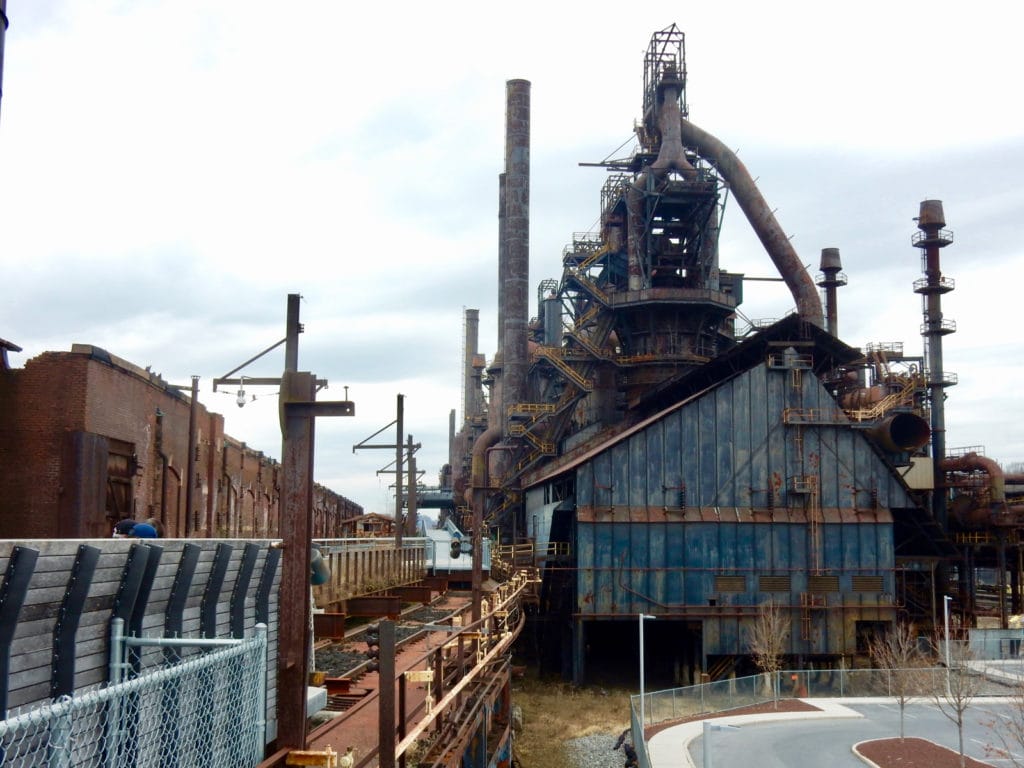
Bethlehem Steel, which you may recall from Billy Joel’s song, Allentown (“Out in Bethlehem they’re killing time/Filling out forms/Standing in line”) once employed 30,000 people. It closed down in 1995 after 135 years.
Five behemoth blast furnaces once emitted cobalt-blue flames. Lined side by side for a quarter mile, they were the focal point of this working class town. Proud Bethlehem Steel workers turned out the girders that built the New York City skyline, the Golden Gate Bridge, and thousands of structures in between. During WWII, Bethlehem Steel was the largest battleship builder in the world.
Steel Girders to Steel Guitars
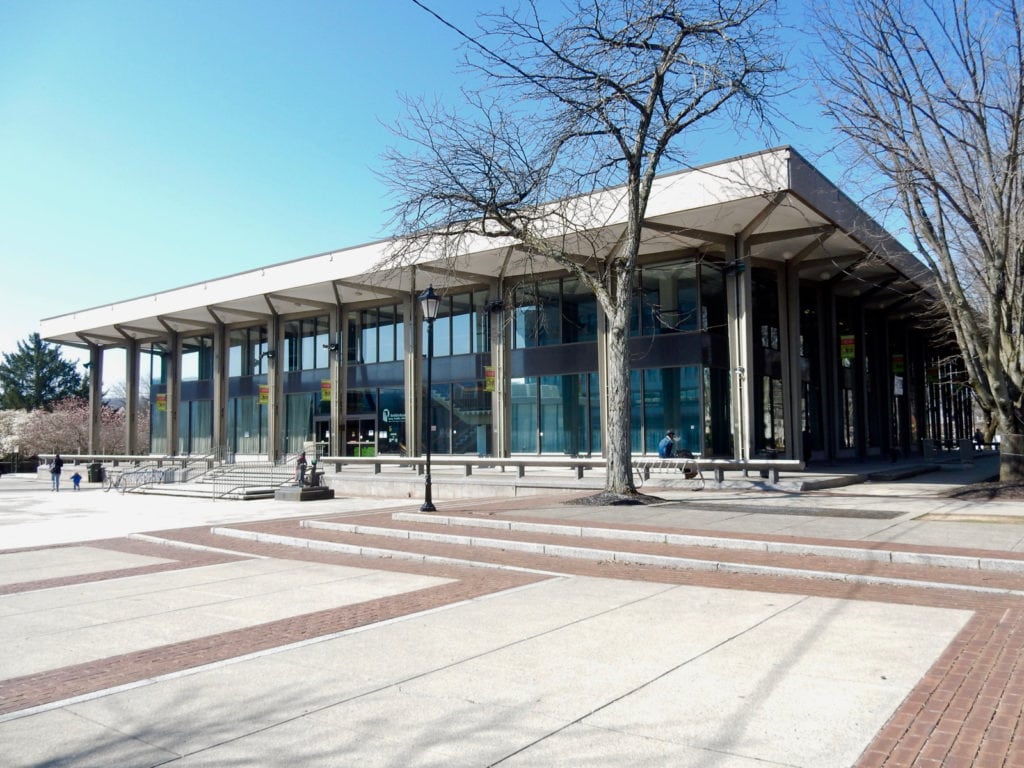
After it closed, the steelmaking campus became the largest Brownfield redevelopment site in the United States. It now honors the factory’s history and workers with a Smithsonian affiliate Museum of Industry. And the complex encompasses one of the country’s largest Arts and Cultural organizations – Arts Quest.
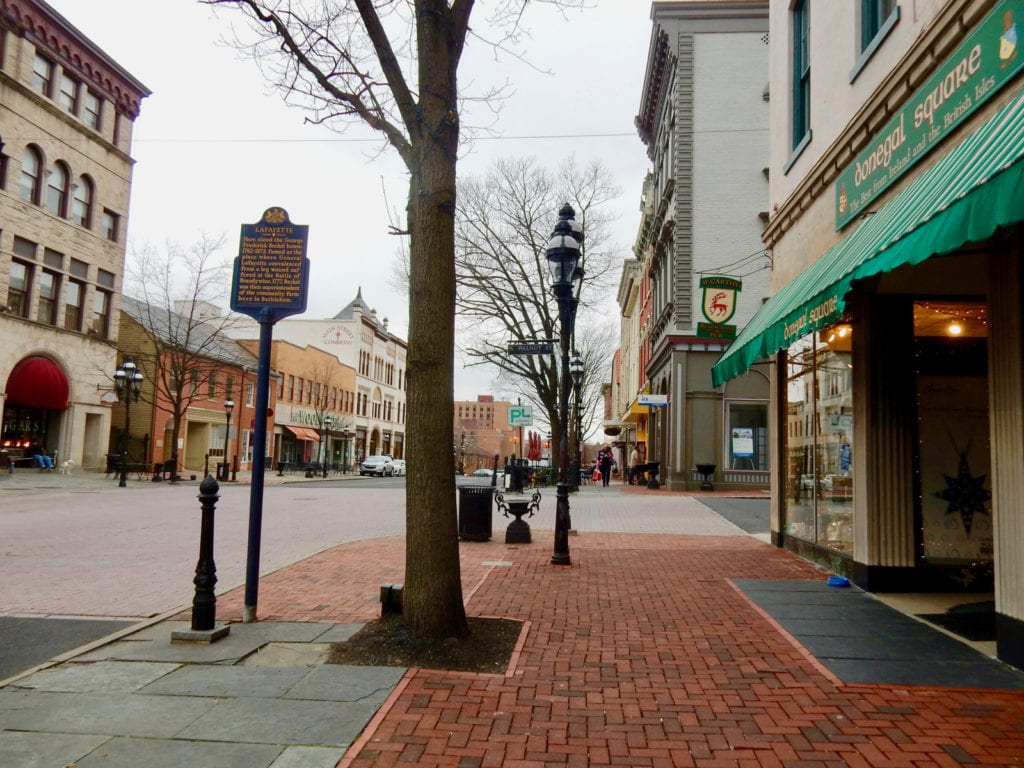
Want to get within inches of those Blast Furnaces? Bring out your inner engineer on several walking tours and museum visits? See behind the scenes of a Decorative Arts museum? Watch a classic guitar being made? Learn the evolution of the Mack Truck (in Allentown – Lehigh Valley’s largest city)? You can do it all, plus eat like a Steel Magnate, and stay like a tycoon on this Lehigh Valley PA Getaway.
And, should you wish to find more dreamy quick overnights in Pennsylvania, check out our Best Romantic Getaways in PA post.
Things to Do in Bethlehem PA and Surrounding Lehigh Valley
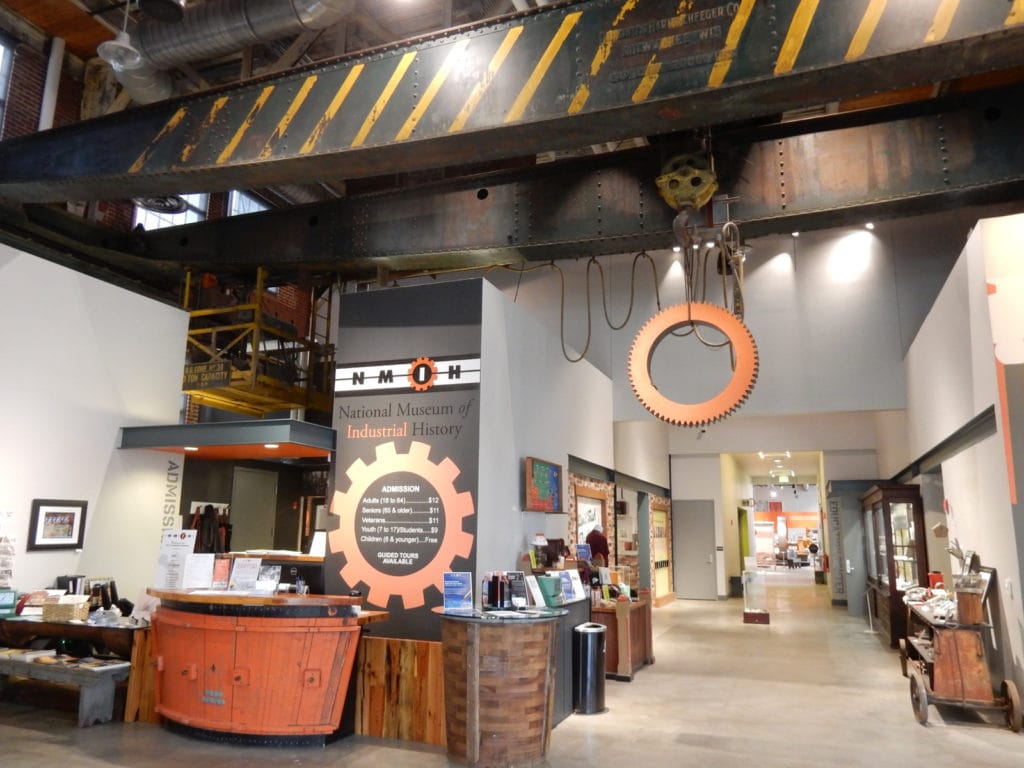
VISIT: National Museum of Industrial History, a Smithsonian Affiliate
Situated inside Bethlehem Steel’s 1910 Electrical Repair Shop, the soaring National Museum of Industrial History is loaded with completely restored innovations of yesteryear. In addition, it houses a collection of industrial machines from the 1876 International Exposition in Philadelphia.
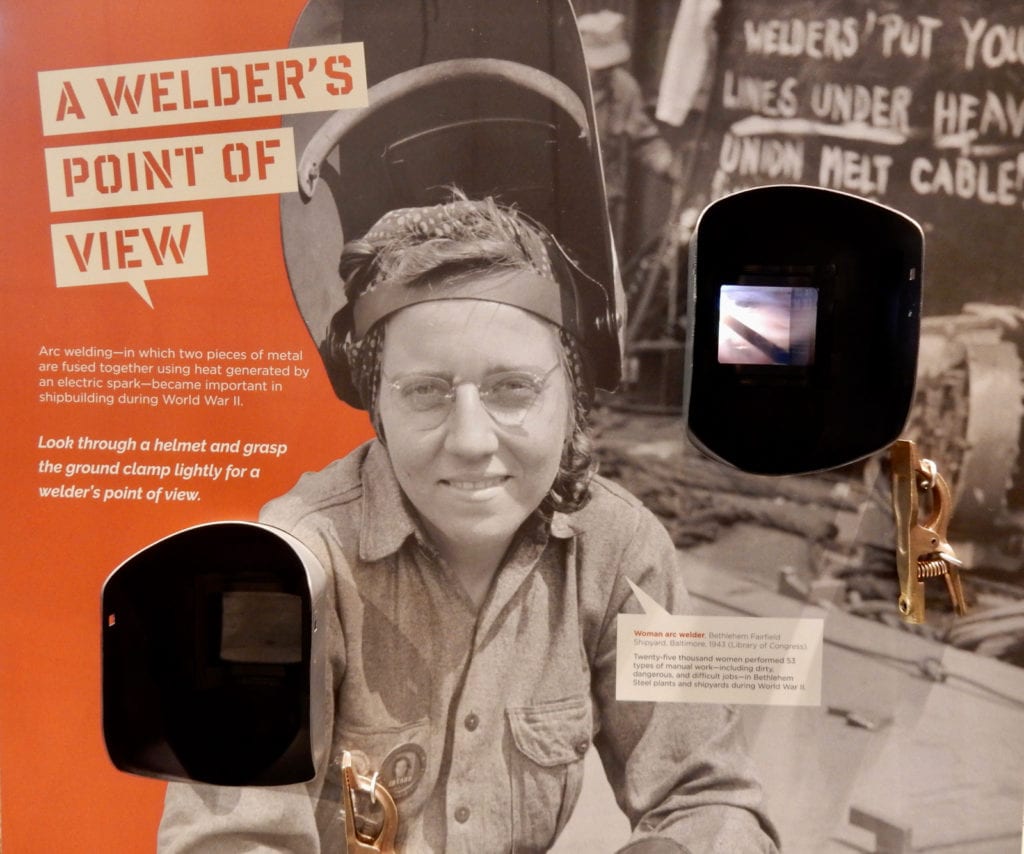
It’s an interactive and impressive look at ingenious feats of engineering, developed without the aid of computers. There are buttons to push and interactive exhibits for the kid at heart. Crank the Flywheel. Engage gears. “Fly” over a propane refinery in a virtual hot-air balloon. And, place your face in a welder’s helmet.
You can also see rare video footage of macho Victorian men doing unbelievably dangerous things, like messing around with a red-hot block of steel, testing out the new 1891 Steam Hammer that comes down nearly on top of their heads. OSHA? What’s that?
Take a Guided Tour
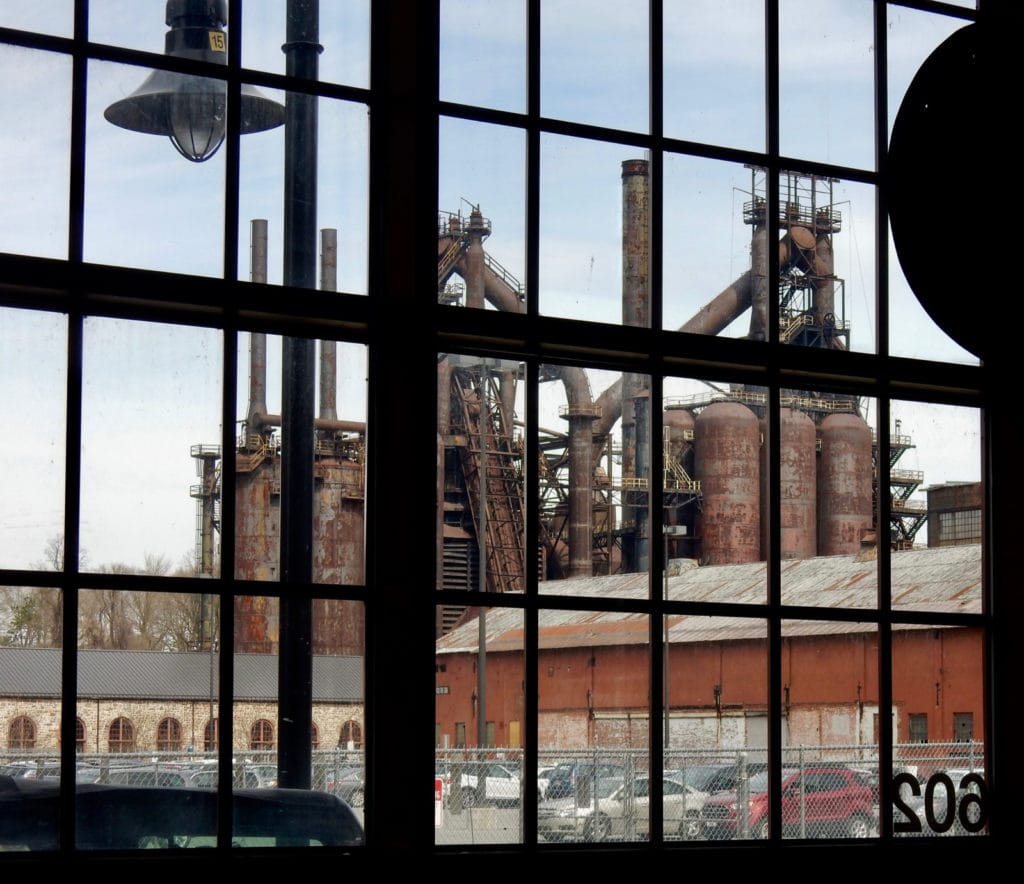
The best way to hear the stories and learn some hair-raising history is by guided tour. Learn the significance of the artsy shadow box displaying metal files from Nicholson File Co.
See the first table saw ever manufactured, and the first compressed ammonia “chiller” ever made, initially for beer breweries in Switzerland.
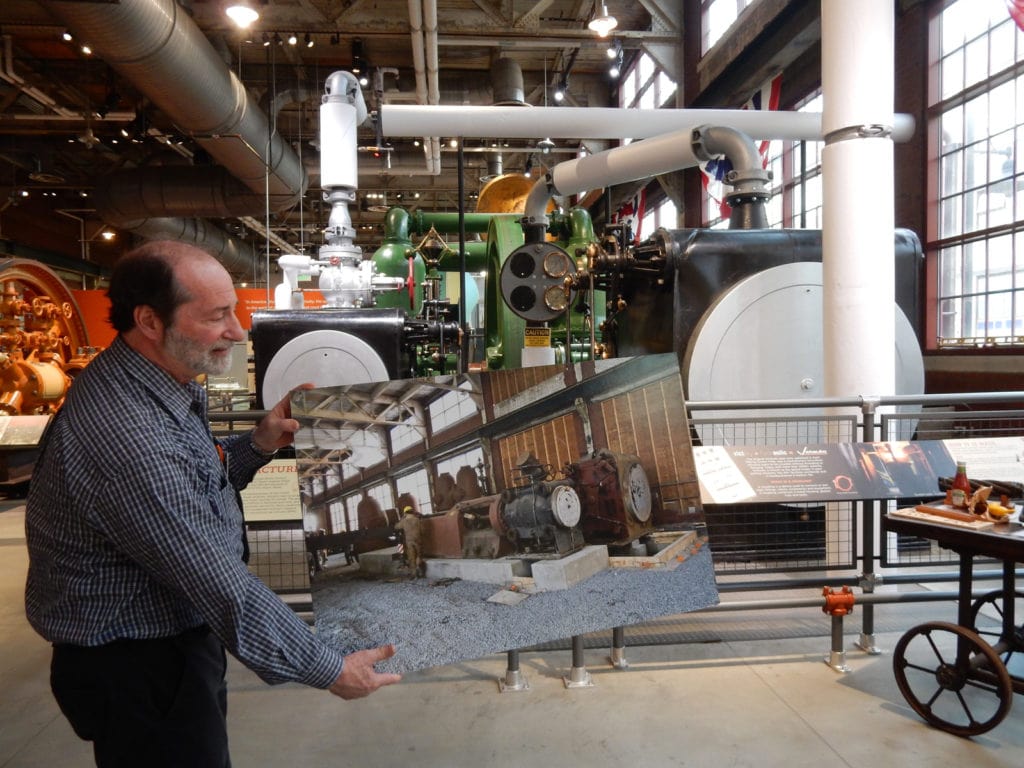
The 1914 Corliss Water Pump – built for the city of York PA – was in bad shape when it arrived here. Luckily, restorers found a chip of its original color, so it’s been returned to a lustrous green. Incredibly, the ole pump is operational once more.
Of course the heart of the museum concentrates on Bethlehem Steel.
Discover the difference between cast, forged, and rolled steel I-Beams, and H-Beams. The advent of these stronger beams enabled the building of skyscrapers to unimaginable heights, and transformed the skyline of NYC. (80% of which was built with Bethlehem Steel).
Lehigh Valley Silk Mills
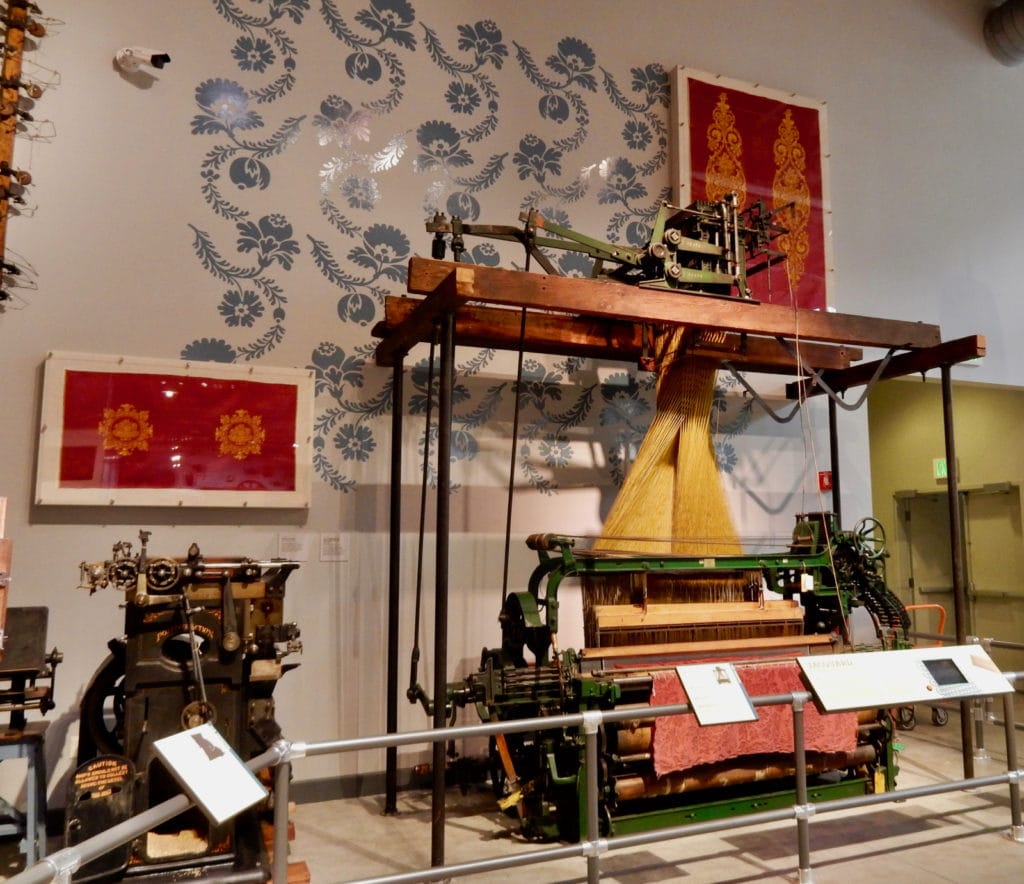
In the 1890’s the Lehigh Valley was replete with Silk Mills. Visitors can feast their eyes on several computer-like Jacquard Looms that wove complexly patterned textiles, some that ended up in the White House.
Another exhibit highlights Walter Snelling, the chemist who founded the propane industry. To ship the explosive gas, 63,000-gallon propane distribution tanks were fabricated by, you guessed it, Bethlehem Steel, and sent by railroad all over the country. Consult website for operating hours and entry fees.
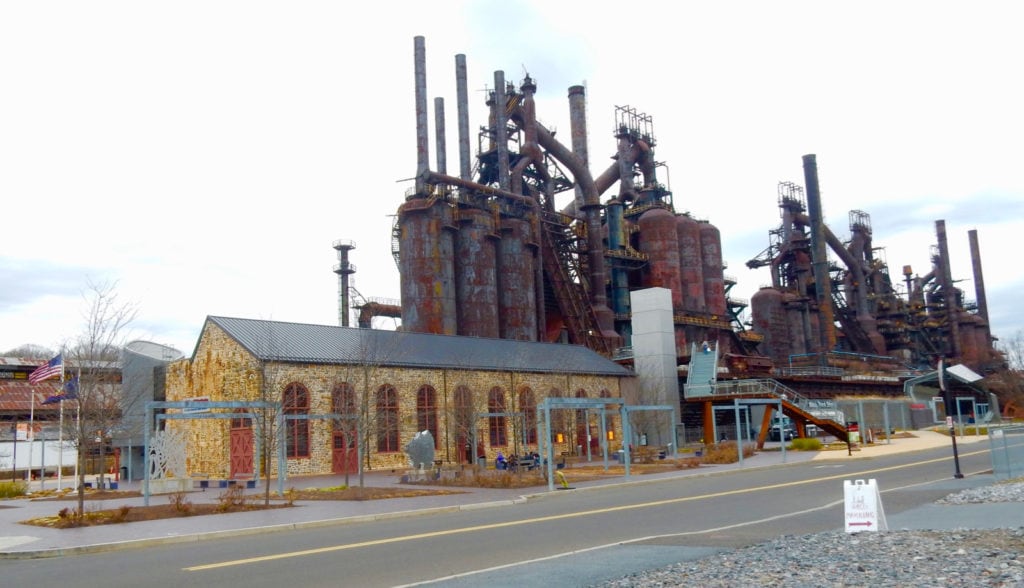
WALK/PHOTO OP: The Hoover-Mason Trestle
Hovering 46 feet above ground and adjacent to the 250 ft tall blast furnaces, the Hoover-Mason Trestle on the Bethlehem Trail Park is New York City’s HighLine on steroids. It is, in its glorious decay, an Instagram darling.
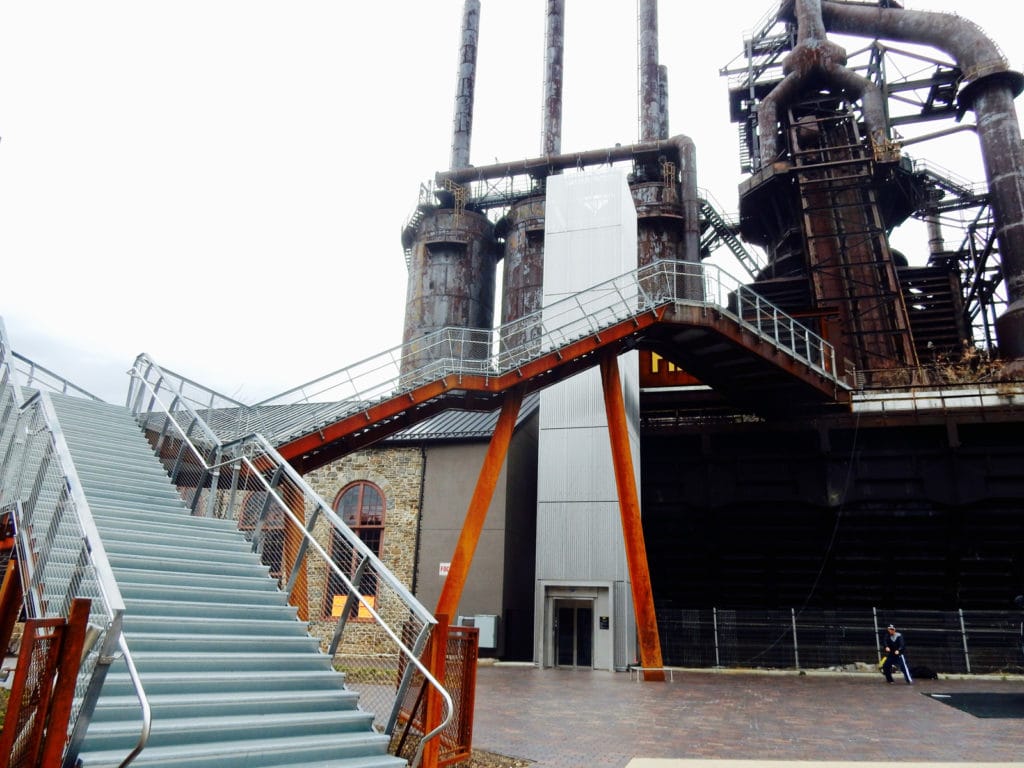
Start in the SteelStacks Visitor Center (across a large parking lot from the National Museum of Industrial History), and climb two stories (or take an elevator) to the steel walkway, which traverses the tracks that transported iron ore to the blast furnaces.
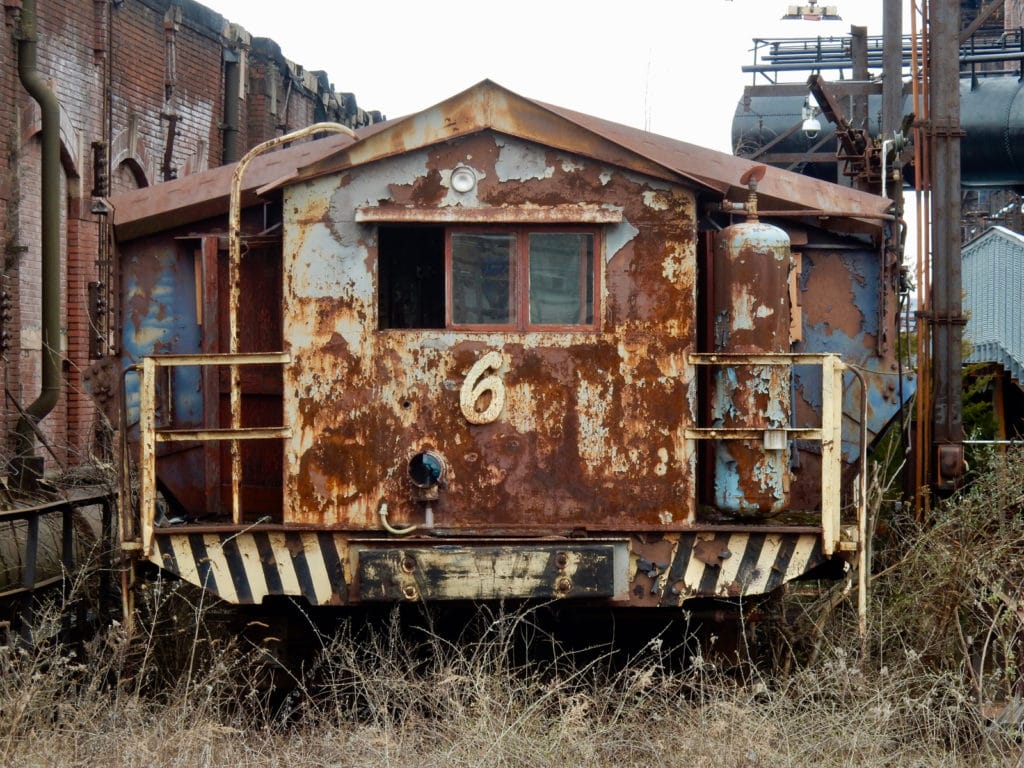
Even if you’re not on a guided tour, you’ll get a pretty good overview of what happened here from excellent signage and informational plaques.
TOUR: Lehigh University, Bethlehem Pennsylvania
Established in 1865 by Asa Packer, who, with Robert Sayre (see below under Where to Stay) founded Bethlehem Steel, the mountainside Lehigh University encompasses multiple Historic Buildings.
Be sure to check out the National Civil Engineering Landmark, Fritz Engineering Laboratory, donated by and named for John Fritz – Bethlehem Iron Company’s first Chief Engineer. Also, the Linderman Library is listed among the country’s most beautiful college libraries. Check website for tours, or take a self-guided tour.
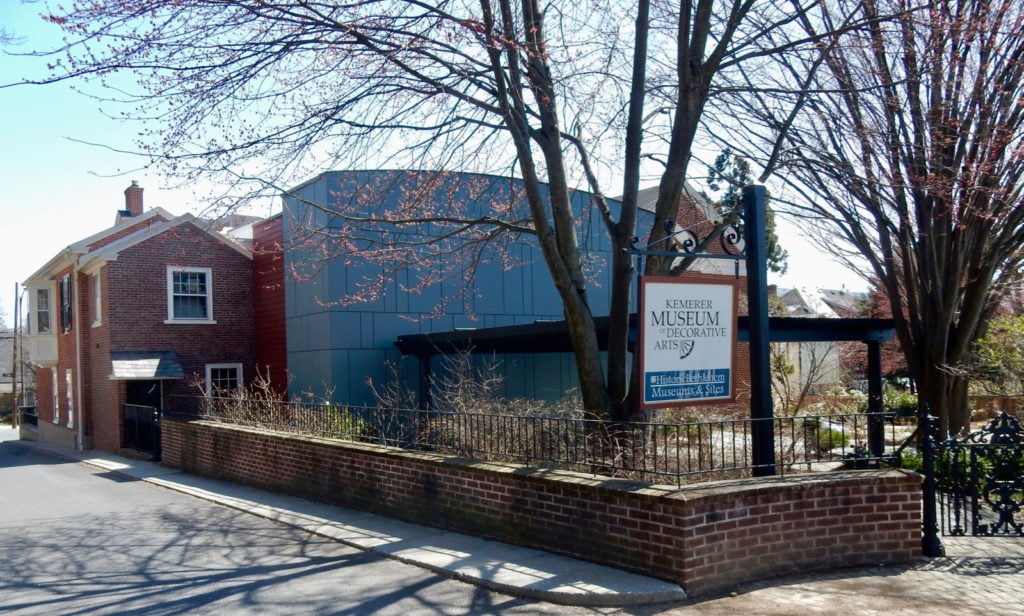
VISIT: Kemerer Museum of Decorative Arts, a Smithsonian Affiliate
When grief-stricken Annie Kemerer lost both her son and husband to untimely deaths, she turned to decorative arts collecting for comfort and beauty. Kemerer died in 1951, having bequeathed her entire collection to Historic Bethlehem, which created the Kemerer Museum of Decorative Arts in her honor.
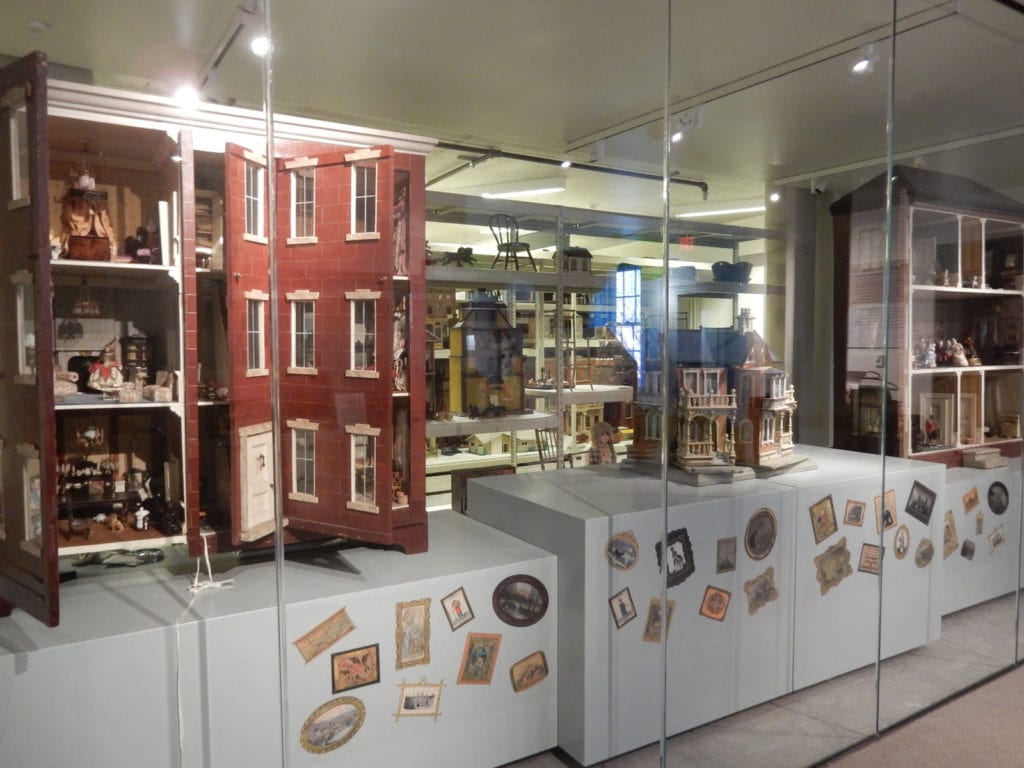
In 1954 Kemerer’s decorative arts collection stood on the Moravian College Campus. In 1966, Pennsylvania’s only museum dedicated to the decorative arts moved to its permanent spot. The collection, highlighting three centuries of style and design throughout period-interpretive rooms and galleries, unites three separate buildings into one great institution.
Check out tons of Bohemian glass, needlework, tall case clocks, cast iron toys, furniture, landscape paintings, and so much more.
A much extolled temperature controlled glass vault sits in the center of the museum. This unique space serves as a viewable storage area and protective room for the Kemerer’s permanent collection, which includes its most popular exhibit, the Elizabeth “Betts” Johnston Prime’s Dollhouse Collection.
Elizabeth “Betts” Johnston Prime’s Dollhouse Collection
Ironically, the childless and rather eccentric Prime started to acquire these playthings after her divorce in the 1970’s. As opposed to traditional collectors, Prime didn’t want to purchase miniatures in a state of pristine perfection. Instead, she sought out those that bore “traces of the hands that played with each object.”
Prime accumulated 44 shrunken structures, and over 6,000 figures and furniture, dating from 1830 to 1933. Most are so fragile (not to mention falling apart from use), they require this temperature-controlled environment.
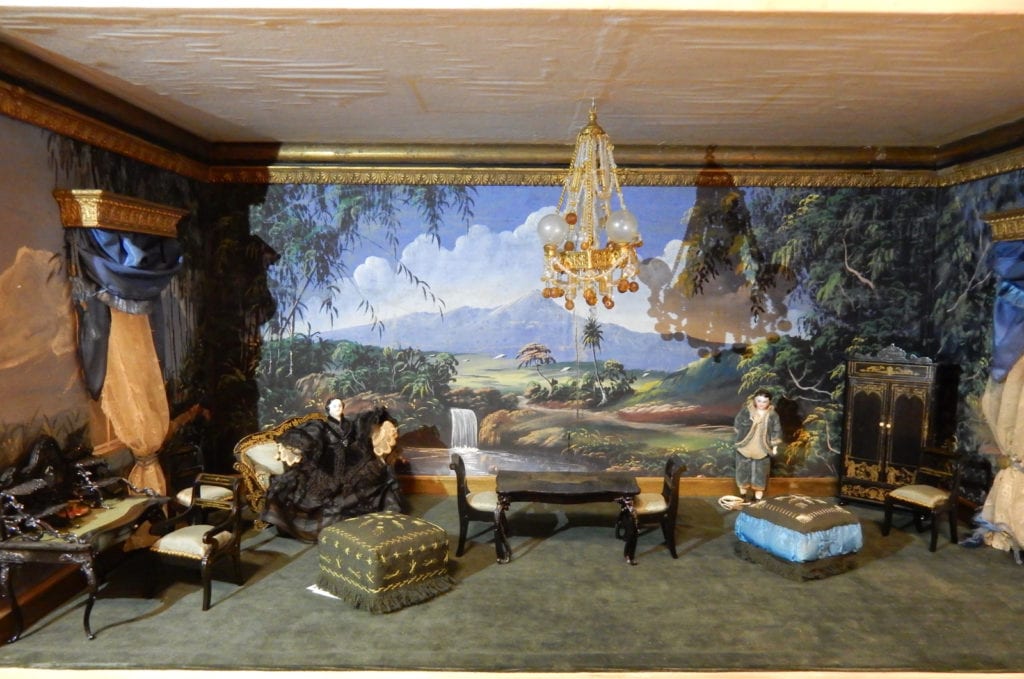
Prime kept her dollhouses, ranging from single and affordable “box rooms” to the 1933 Tiny Toy Mansion (that came fully furnished and cost as much as a brand new car), in her Manhattan apartment. “Betts” placed each piece purposely, often at odd scale (a minuscule princess next to a giant bathtub twice her height). However, she was always mindful of the period.
After her death, friends photographed each tiny house, so that museum curators would know where each piece fit.
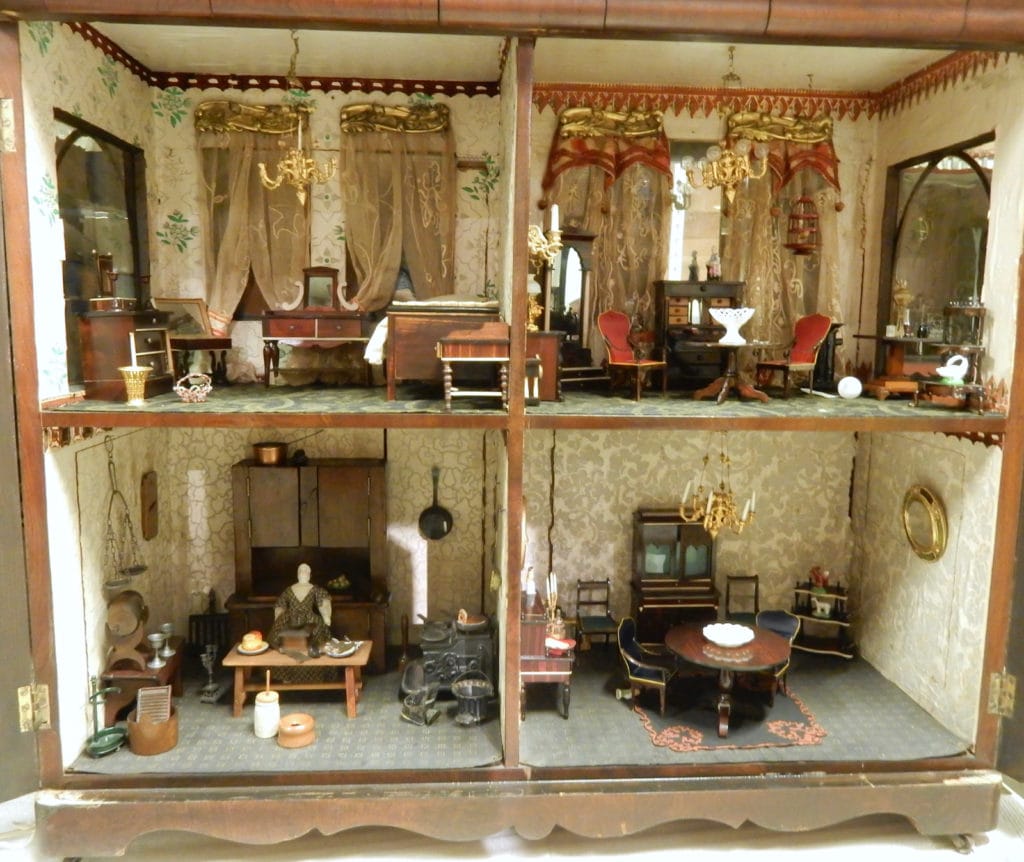
In effect, the Betts Johnston Prime Dollhouse Collection is a perfect collection for this museum, as each diminutive structure boils the decorative arts and interior design of its day down to manageable size. This museum is a must-see for anyone with an interest in interior design. Check website for hours, admission cost, and tour information.
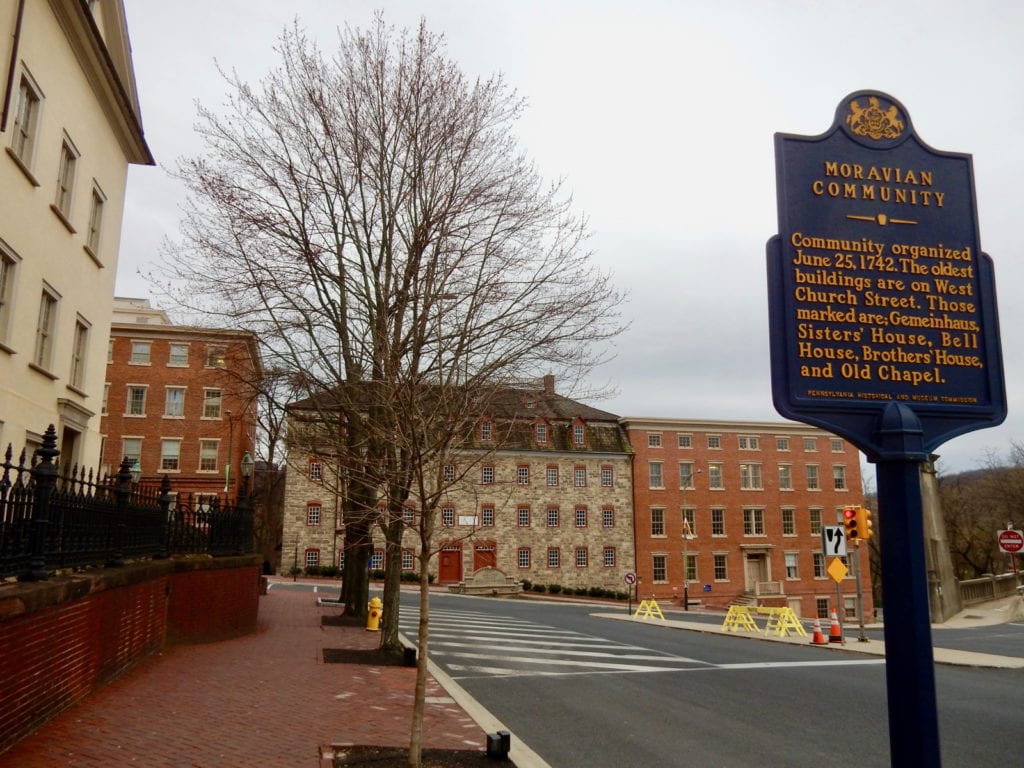
TOUR: Historic Bethlehem Museums and Sites
** This just in (September 2024): Historic Bethlehem is now part of the first-ever transnational World Heritage Site, which includes unique settlements in Germany, Northern Ireland, and Denmark.
Why have Moravians remained so obscure? A visit to the 20 structures managed by Historic Bethlehem provides you with an understanding of this religious immigrant group. Though many of the practices have changed since the 18th Century, there are still a million adherents to this Protestant sect who read the “Daily Text” worldwide. (Copies of bible verses are cut into 365 strips, one for each day of the year, put in a bin, and randomly picked one by one for the Daily Text Book, published annually and translated into dozens of languages).
So why the mystery? A visit here will help you understand.
Visitors Center & Museum Store
Get your bearings, pick up information or begin your walking tour in the Goundie House, original 1810 home of Bethlehem’s Town Brewer and community leader, located on Main St.
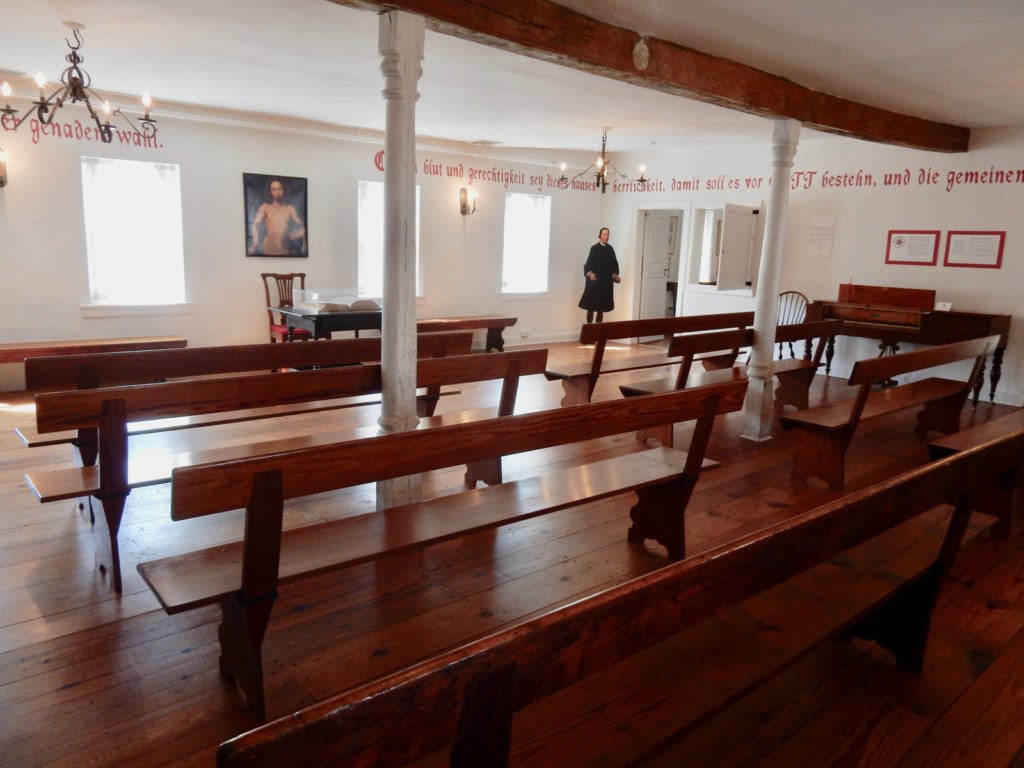
Start in the Moravian Museum of Bethlehem Known as the 1741 Gemeinhaus (“Community House”)
The Gemeinhaus (now the Moravian Museum) was a multi-purpose building – composed of living, working, and worship sections. Community members gathered in the “Saal” – a large chapel considered the first house of worship in Bethlehem PA.
A Christian denomination formed in 1457 (50 years before Martin Luther) as protest against the Catholic Church, the Moravians, who hailed from Moravia in what is now within the boundaries of the Czech Republic, were (and still are) progressive, industrious, and musical.
Initially, the Moravians sought sanctuary in Saxony, on the land of Count Nikolaus von Zinzendorf, who also funded their community and missionary work. Zinzendorf came to the American Colonies in 1741 to check on one community of missionaries.
Origins of the Town Name
While here, he named the settlement Bethlehem during a Christmas Eve “Love Feast” – a celebratory ritual that still continues to this day, mostly for weddings and anniversaries.
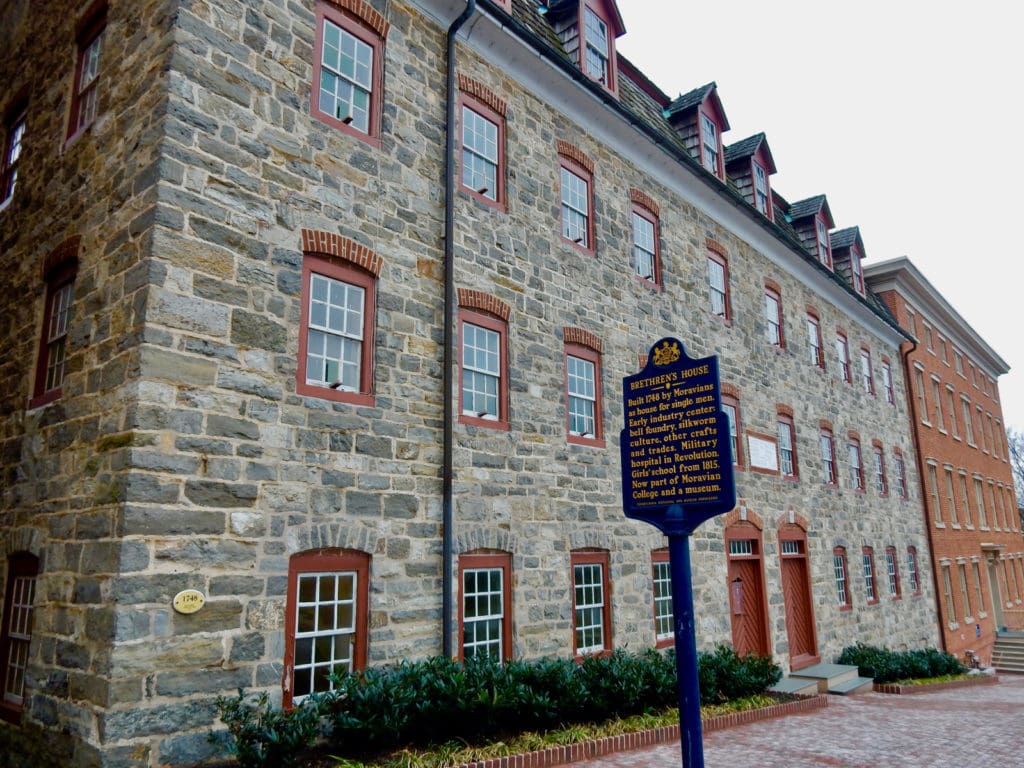
Revolutionary for the time, Moravians believed in equality for everyone: women, men, White, Black and Native. Though German was the lingua franca, many Moravians spoke 15 languages, including the tribal Mohican, Mohawk, and Lanape. Women were well-educated and held government positions. And Native Americans and African Americans who converted to Christianity were welcomed into the community.
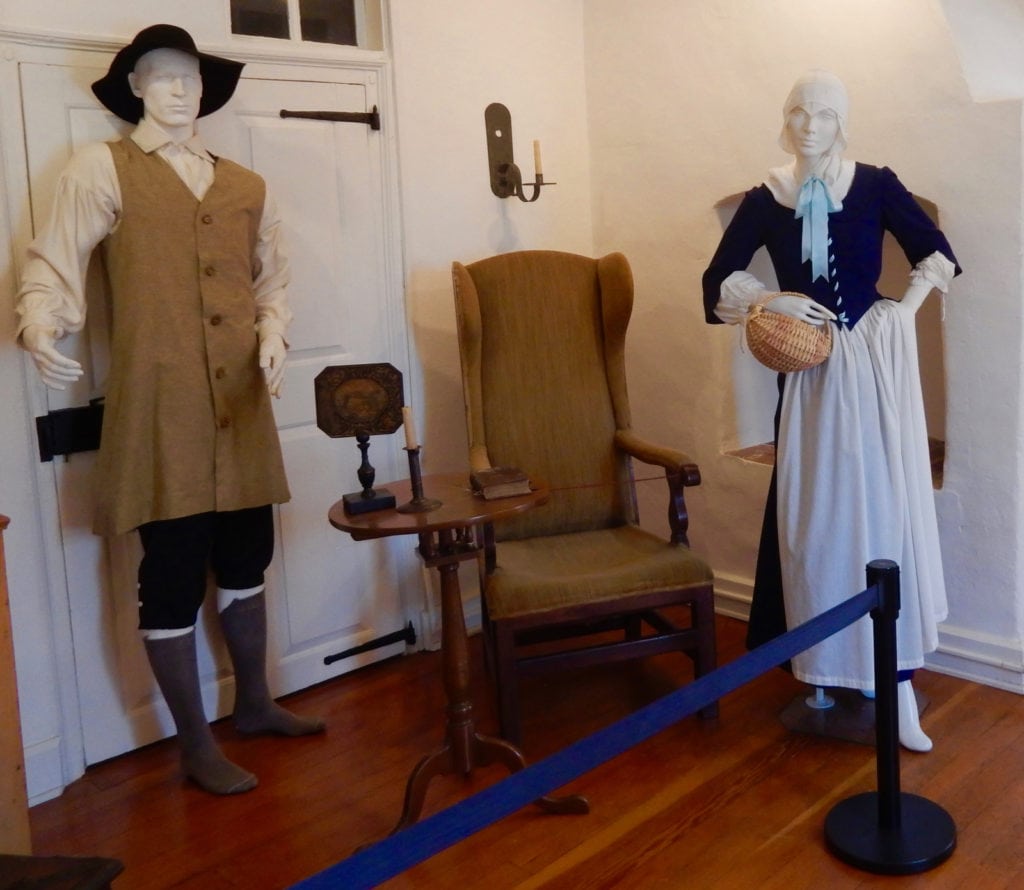
Single men, single women, widows, and married couples lived in “Choirs,” separated into communal dormitory buildings. Women wore distinct clothing: “bird beak” caps, and dresses with ribbons of different colors indicating youth, single, married, or widowed.
Origins of Moravian Orchestras
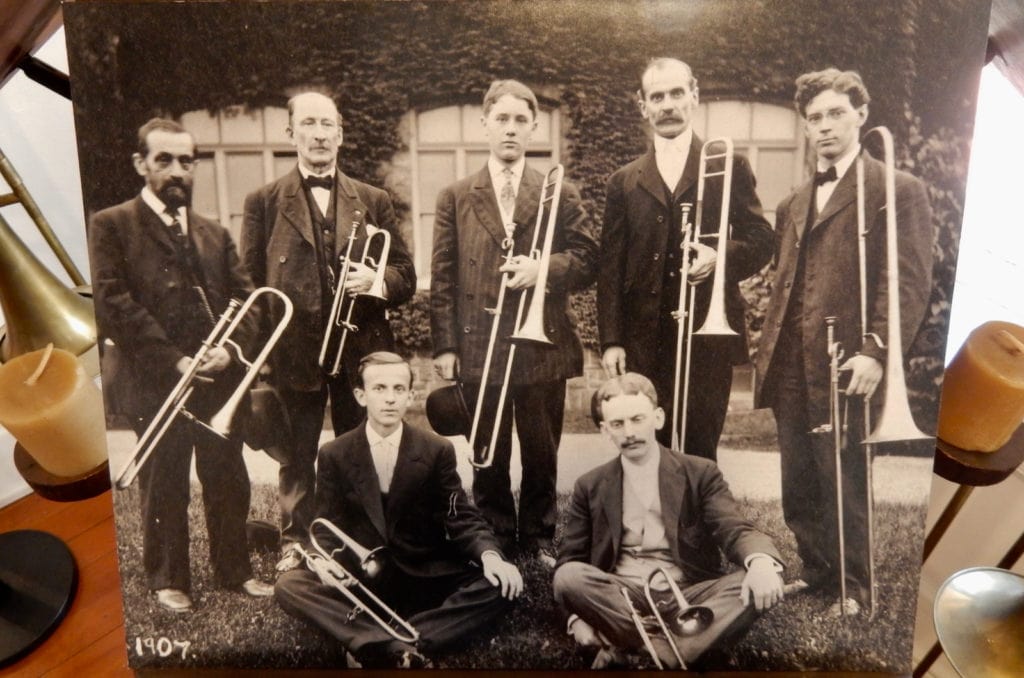
Moravians, still considered excellent musicians, organized one of the earliest orchestras in the colonies in 1740. They played the latest compositions of Bach and Hayden. The Moravian Trombone Choir, established in 1750, was the oldest organized brass bands in the USA. And, astonishingly, they are still playing!
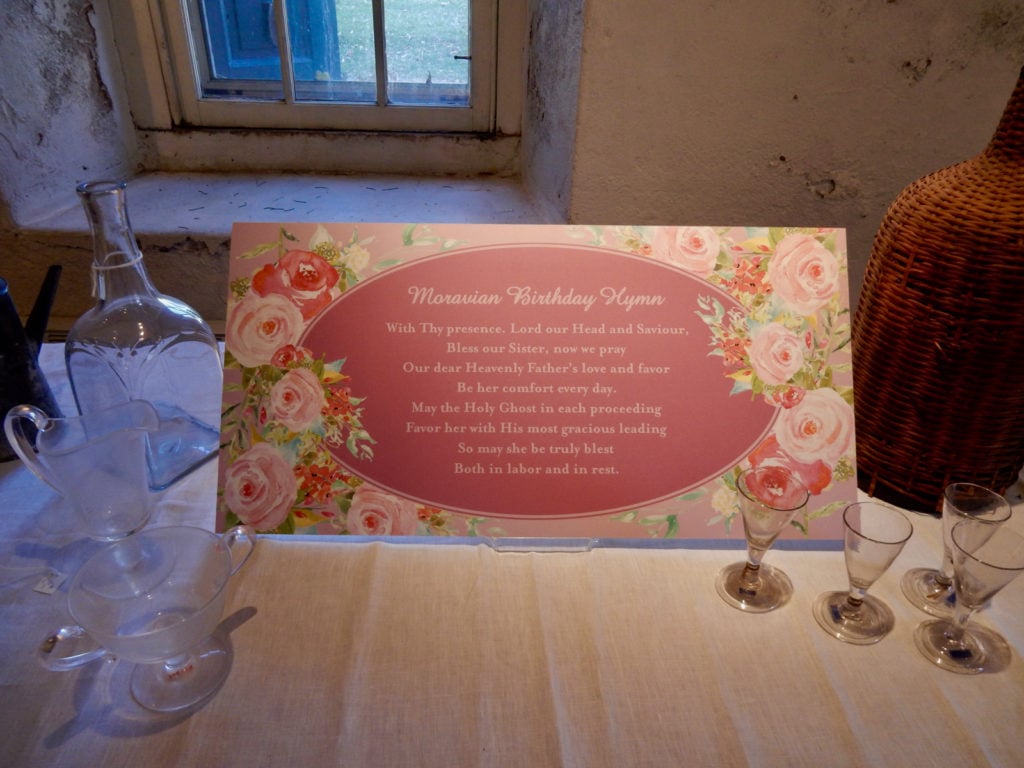
Single Sister’s House
Next door, step into the Sister’s House for an idea of how the community incorporated women in art, medical care, farming, and other trades. Women were ordained as ministers, held their own services, and celebrated birthdays much like we do today. With cake and song.
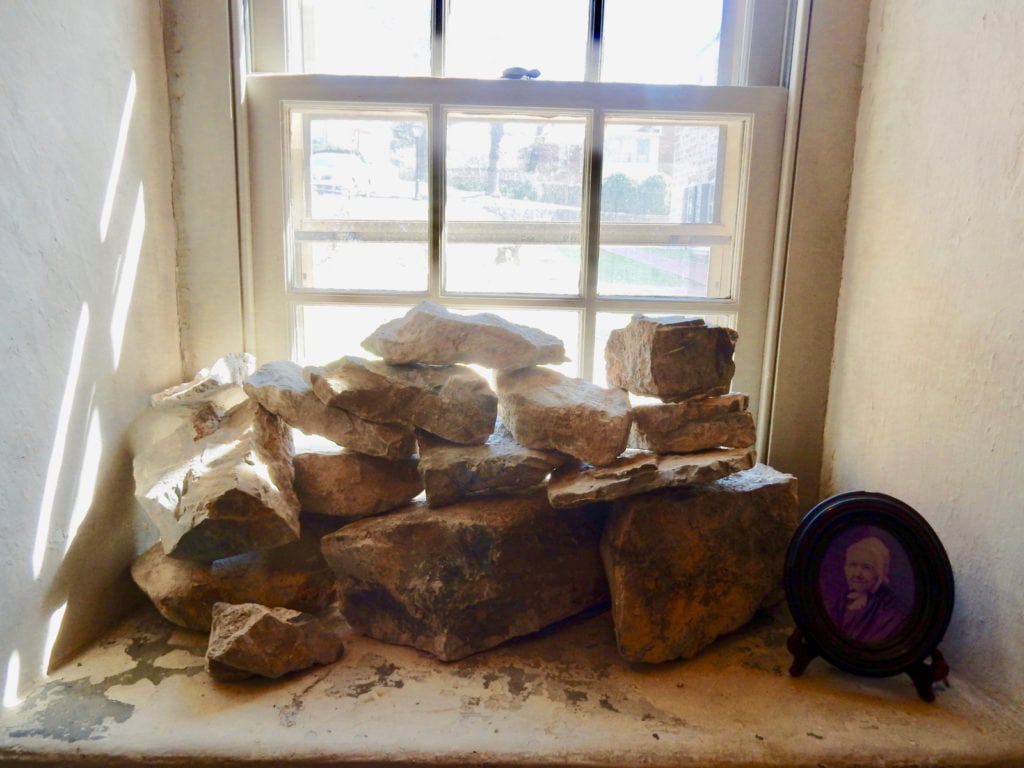
A pacifist sect, Moravians didn’t serve in the military. But during the French and Indian Wars, women kept rocks on windowsills to scare away, though not kill, potential attackers.
The last single Moravian women moved out of the Sister’s House in 2007. You can peek into her spare apartment. Her mailbox remains on the outside of her door.
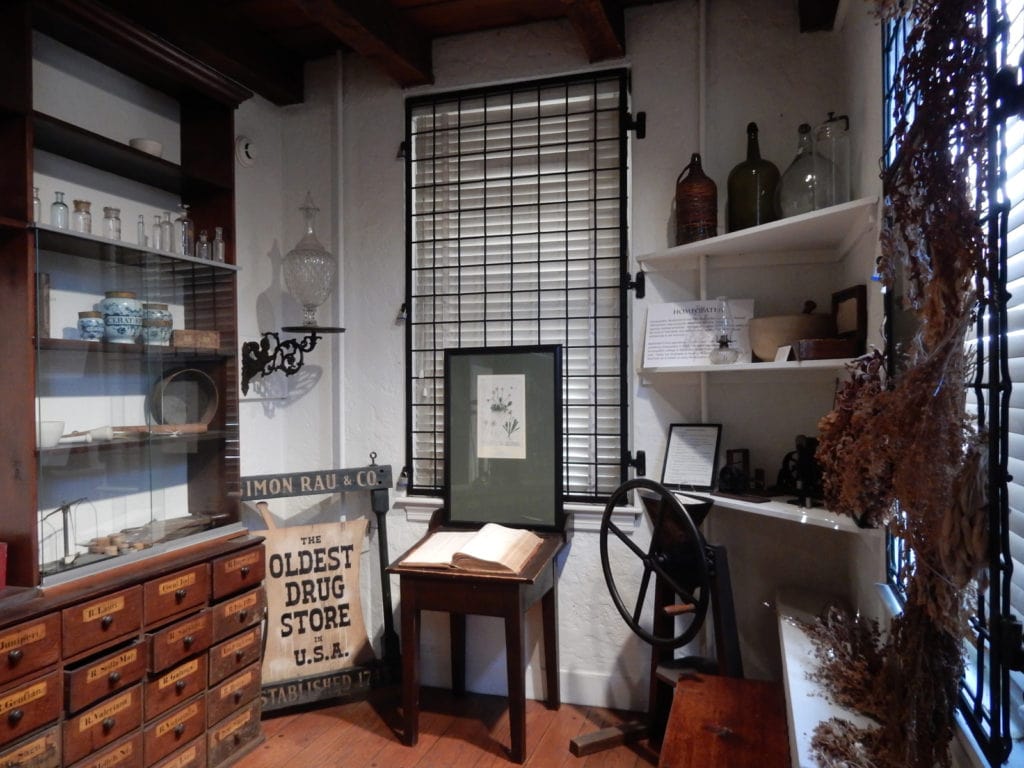
1752 Apothecary
The tiny 1752 Apothecary was the oldest continuously operating drug store in this country until it closed in the1950’s. More progressive medically than many at the time, Moravians didn’t practice bloodletting. They instead prescribed the more contemporary remedies of bed rest and hydration for ailments.
Delft Ceramic and glass medicine jars and bottles still line shelves, and a 1880’s prescription record book reveals the types of prescriptions and their cost. Undeniably lower than it is today.
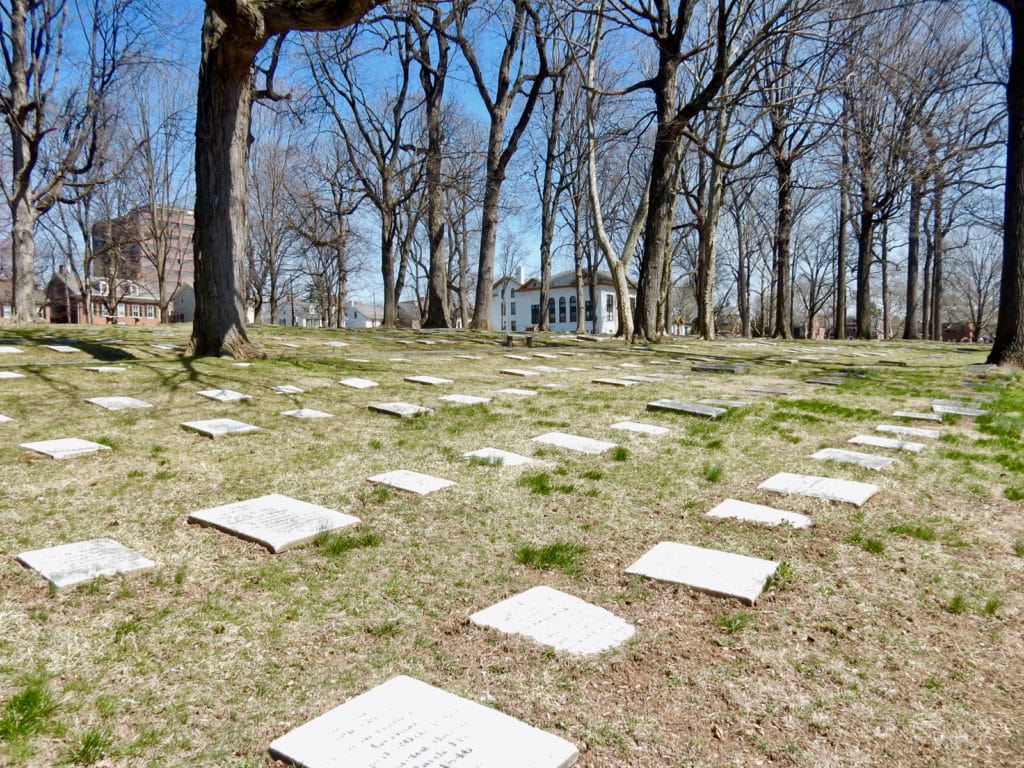
God’s Acre Cemetery
As all Moravians were equally valued member of the community, tombstones are of similar size and lay flat on the ground. Americans of European, African, and Native descent are buried side by side.
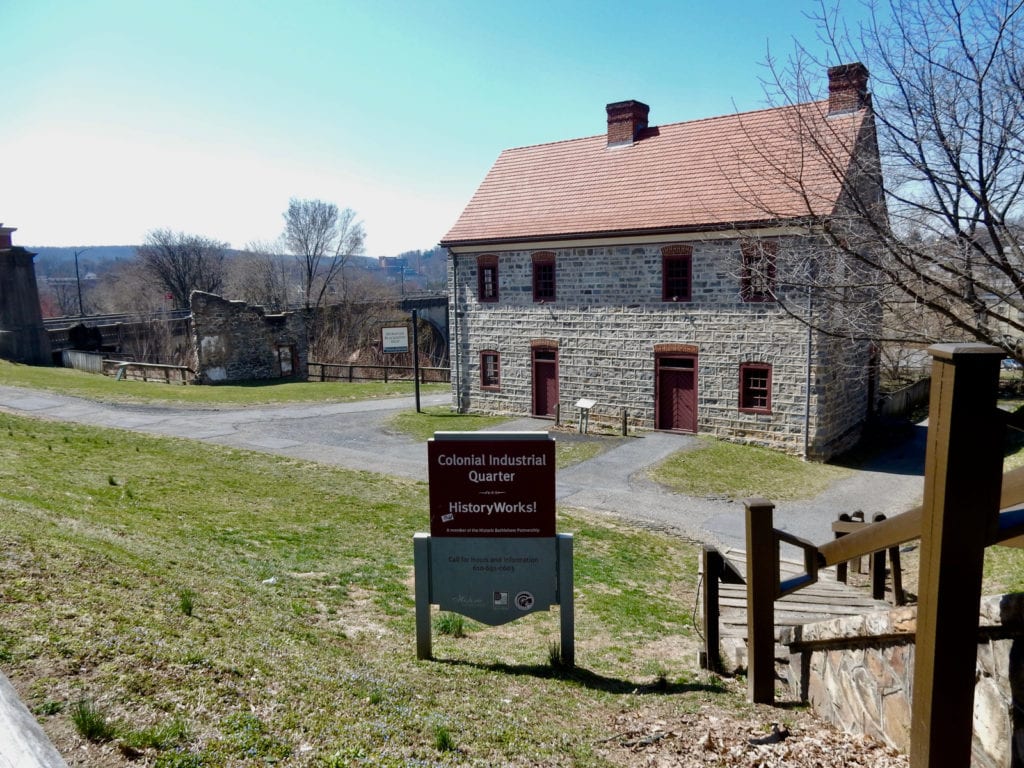
The Colonial Industrial Quarter (behind Hotel Bethlehem)
Bethlehem’s original Colonial Industrial Quarter is now composed of ruins, restored structures, and replicas of industrial buildings. The Quarter was positioned at the base of the hill on Monocacy Creek, where fast flowing water could power early industrial waterwheels.
There’s a circa 1761 Tannery, a working Blacksmith Shop, a replica of the Luckenbach Flour Mill (rebuilt on the same footprint as the original, that now serves as a programming space), the Spring House, ruins of the Butchery, Pottery, and Dye House, and the historic Waterworks.
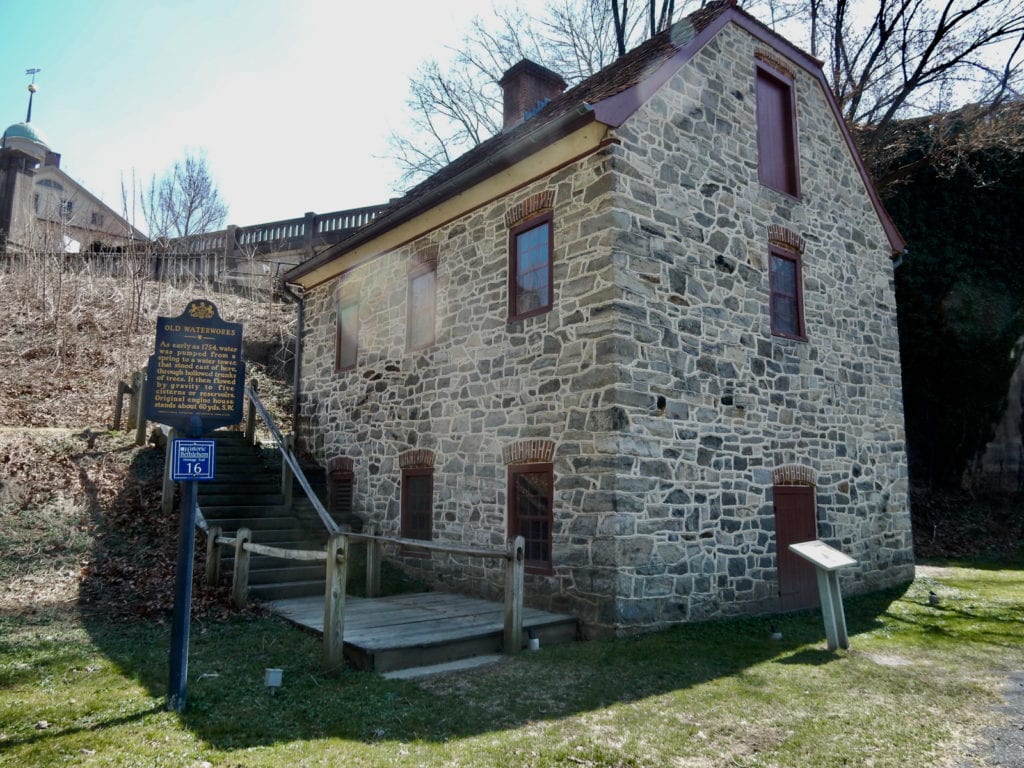
The Old Town Waterworks
Built in 1762, this was the very first pumped municipal water system in the country. It stands today as both a National Historic and National Civil Engineering Landmark. Positioned over a sweet water spring, the pumping station used foul water from the Creek to power the waterwheel that drove potable water to homes built uphill (safe from potential flooding). This system was in use for over 100 years, until the mid 1800’s.
There are several ways to access the gardens, meadows, industrial buildings, museums, and sites that encompass Historic Bethlehem. Historic Bethlehem offers a number of much lauded Walking Tours. Find your favorite here.
DO: ArtsQuest
Listen to music, see a show, or participate in an art project year round at ArtsQuest, first opened in April 2012 amid rusted out 230 ft. high smelters, on what is known as the “Steel Stack Campus.” Bethlehem’s flagship festival is Musikfest, the “Largest Free Music Festival in America.” This mostly free summer Blues and Rock music festival plays out on 15 stages over twenty acres. Here’s a secret –stand on the Hoover Mason Trestle for great concert views.
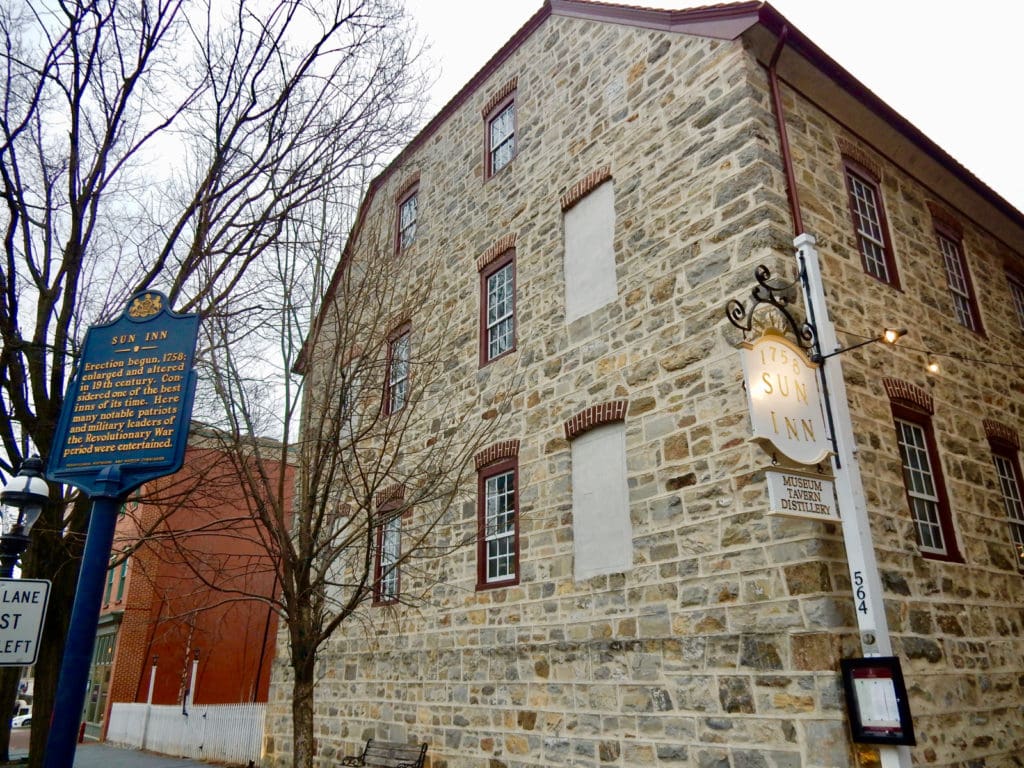
VISIT/EAT: Sun Inn
Put your John Hancock where the original did – at the Innkeeper’s desk of the 1758 Sun Inn. Once on the frontier of these not yet United States, this place was probably a welcomed slice of hospitality and civilization when it received its first guest in 1760.
George and Martha, John Adams, Benjamin Franklin, and most New American dignitaries found their way to this little outpost. The Sun Inn is now a Museum and Tavern that also houses Christmas City Spirits – and spirits of another kind. (Sign up for a ghost tour!).
VISIT: Mack Truck Experience Center, Allentown
Currently the Testing and Development facility for all Mack trucks made in the nearby Macungie, PA plant, the Mack Experience Center was opened as a museum in 2010. During WWI, soldiers driving Mack vehicles could see the figure of a bulldog in the trucks’ front grill, and a corporate symbol was born. In 1933, the Bulldog Radiator cap became the identifying feature of every Mack Truck. Plan on about 2 hours to tour the museum, which also houses and theater, sound room, and other interactive exhibits. Check website for hours or to sign up for a free tour.
VISIT: America On Wheels, Allentown
The quirky America on Wheels, a collection of automotive vehicles, includes Pee Wee Herman’s bike, a “lovely Austin-Healey,” go-carts, and antique cars. There’s an old Harley, a UPS Truck that with two million miles on its odometer, and a Stanley Steamer steam-driven car.
Perhaps most fascinating is a mock-up of “Guys Garage,” – a reconstructed garage from the 1950’s stocked with hand tools; not a hint of computer electronics. Check website for days and hours open and admission fees.
TOUR: Martin Guitar in Nazareth, PA (8 miles from Bethlehem)
Yes, one of the foremost guitar manufacturers in the country – Martin Guitar – is located in the Lehigh Valley: just 8 miles from Bethlehem. On your tour of Martin Guitar, you’ll breath in the odor of treated wood. Tread on sawdust. Watch artisans measure, sand, glue, and stain the parts of each Martin Guitar into a burnished, musical whole. Though cut and polished by machine, each guitar is still hand-assembled with the same care and precision that each of six generations of Martins have tendered since CF Martin opened its doors in 1839.
The narrated walking tour takes you past craftspeople working on 8,000 acoustic guitars in various stages of assembly. Nearly 250 are completed every day. Check website for Visitors Center hours, to sign up for tours, and suggested donations.
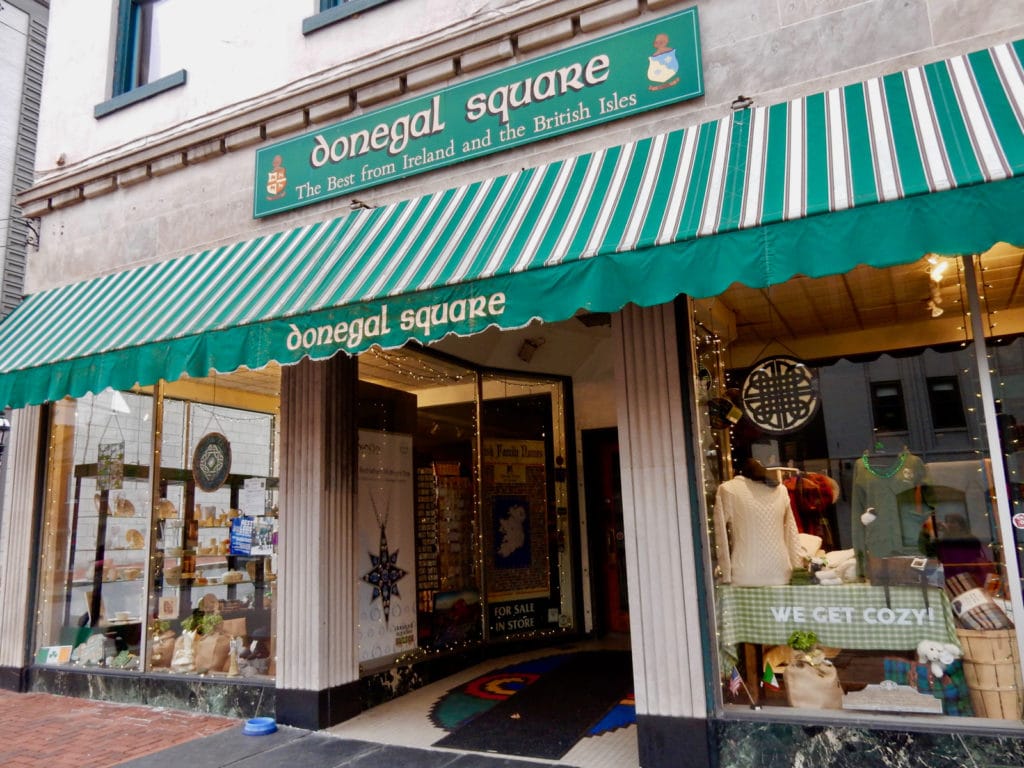
SHOP: Donegal Square
If it’s a Kilt you’ll be lookin’ for, there’s a selection at Donegal Square; your source for everything Celtic.
SHOP: Moravian Book Shop
Next door, visit the the USA’s Oldest Book Store, the Moravian Bookshop opened in 1745. In addition to many books and a dizzying number of gifts, it’s got home goods and even artisanal foodstuffs.
Restaurants in Bethlehem PA
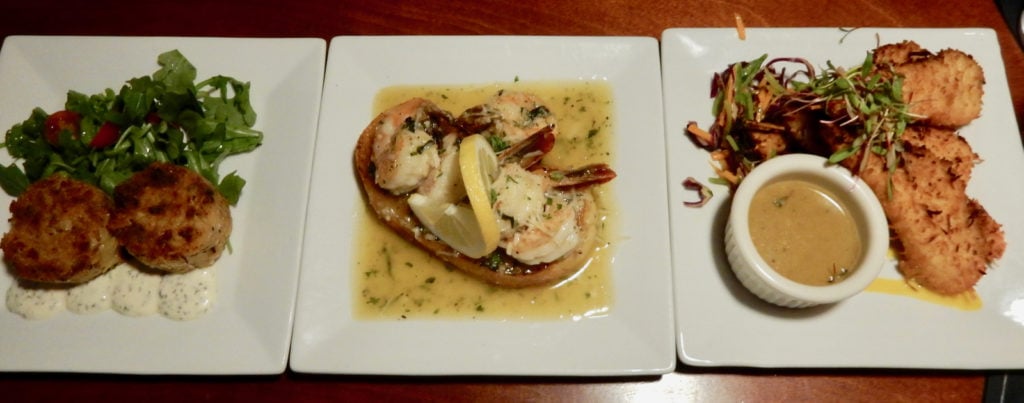
EAT: Apollo Grill
This tried and true Bethlehem landmark, the Apollo Grill, has been at the top of lists many years for a reason. The food is consistently good, and the vibe is wonderfully convivial. I love the appetizers here, like the always on the menu uber-popular Shrimp Limoncello, and oh my gosh favorite Garlic Bread which bears no resemblance to the standard version. This one – a sliced loaf of crusty/soft bread sits of a puddle of delicately flavored gorgonzola sauce and, alone, is worth returning for.
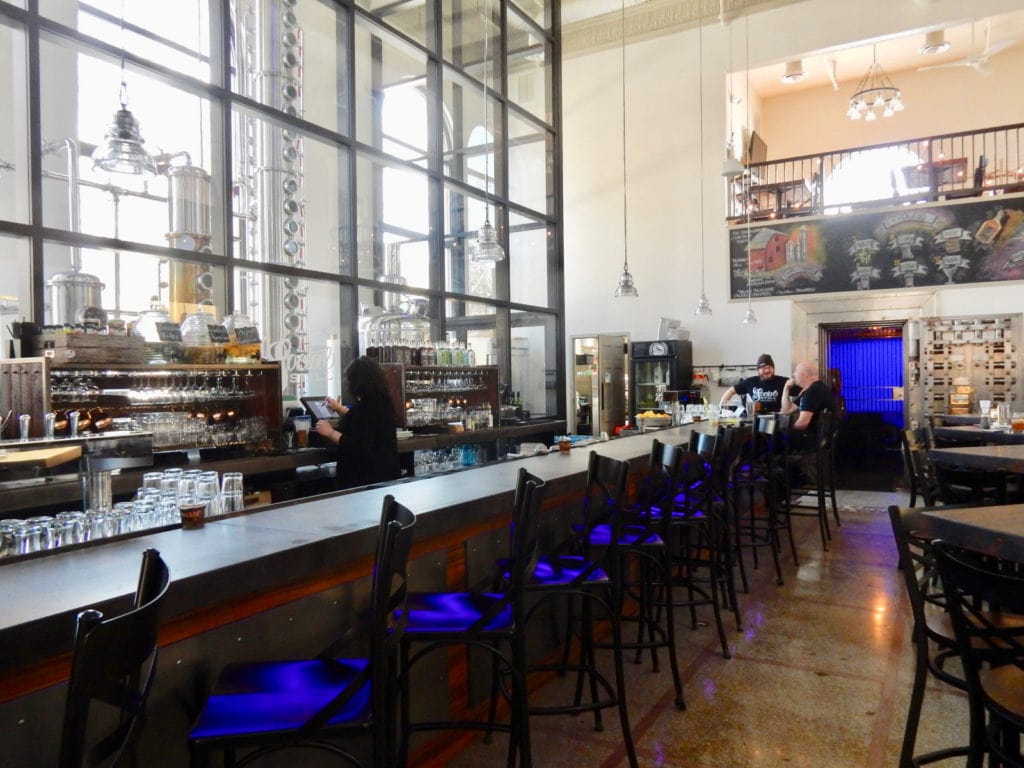
EAT/DRINK: Social Still
There are plenty of vats and stills on view at Social Still, a soaring brewery-distillery/restaurant carved out of a handsome bank building. The menu has expanded over the last few years – and reviews are always positive. The ambiance itself is worth coming for – but your tummy will be happy with anything you choose.
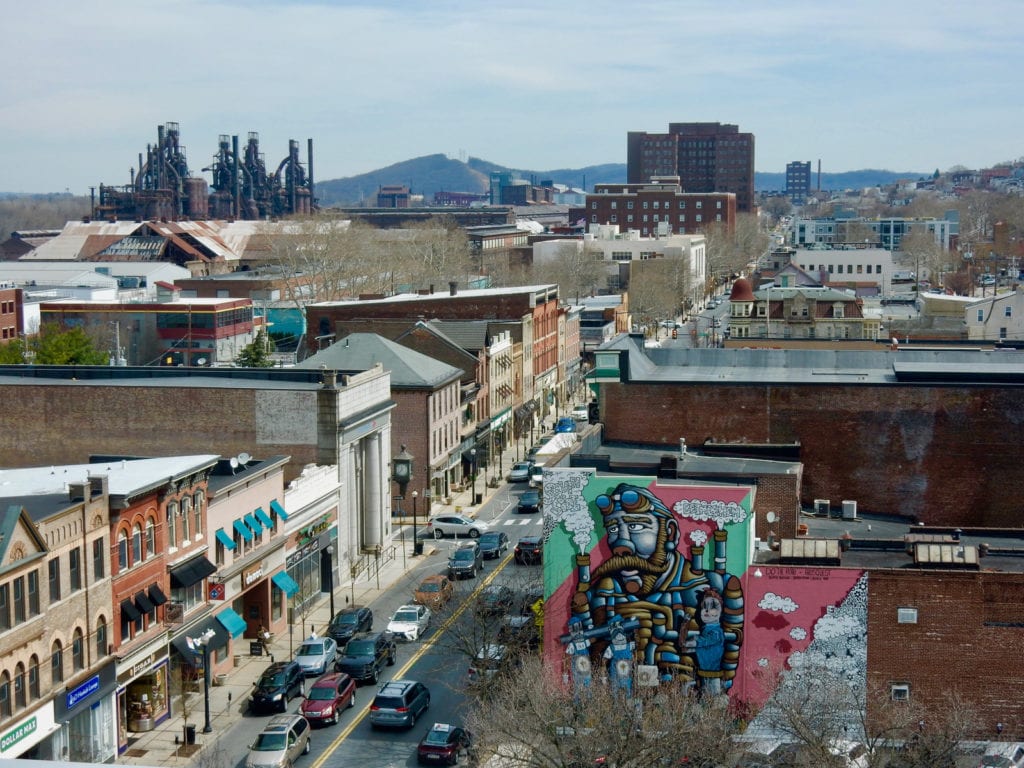
EAT: Zest Bar and Grill
On the 6th floor of a new “high rise” building on the corner of 3rd and New Streets, Zest Bar and Grill‘s good food vies with views of 3rd St. Bethlehem, the Steel Stacks, and the River beyond. This hot place serves up trendy bites like Fried Cauliflower, Tuna Tartar, and more. Along, of course, with excellent cocktails.
DRINK/EAT: The Bookstore Speakeasy
Enjoy a Prohibition-era cocktail at The Bookstore – a candlelit speakeasy literally hidden behind a bookshelf. Enter the low-ceiling, low-lit warren of rooms and peruse the drink menu book, listing a goodly number of inventive alcoholic concoctions. After more than a couple of decades, it’s still of the heppest date-night spots in the Lehigh Valley.
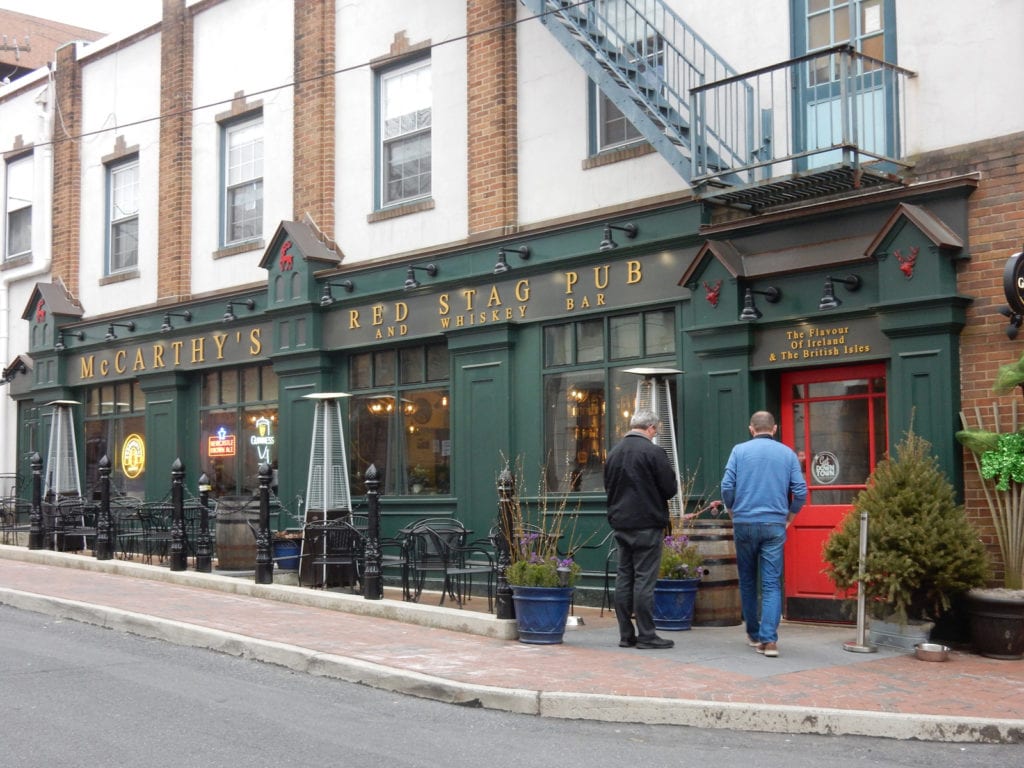
EAT: McCarthy’s Red Stag Pub and Whiskey Bar
Visit the British Isles at McCarthy’s Red Stag Pub, a cozy, unpretentious place, where a pint, a shot of whiskey, homemade soups, and stews will put you right.
EAT: Locals recommend
Bolete for inventive cuisine in a historic home outside the city. F&A Grog House for, well, grog (beer). The Bayou for Southern soul food. Twisted Olive for craft cocktails and casual food. Aqui Es for Mexican.
Where to Stay in Bethlehem PA
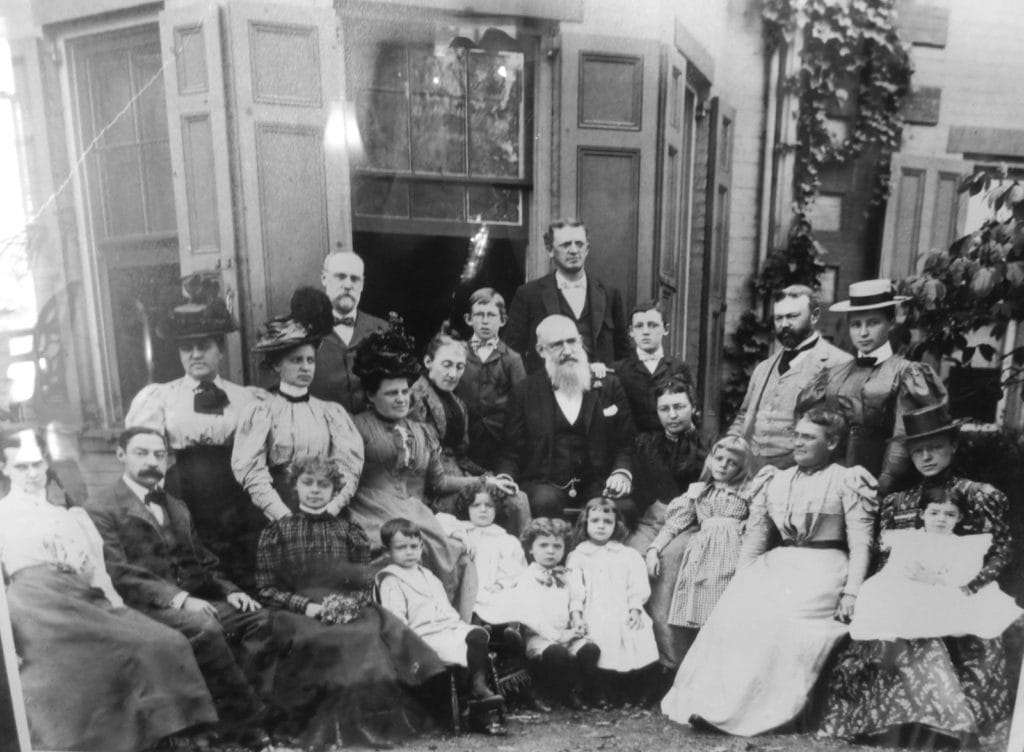
STAY: Sayre Mansion
In 1858, prominent philanthropist Robert Sayre, chief engineer of the Lehigh Valley Railroad, a director of Bethlehem Steel, and trustee of both St. Luke’s Hospital and Lehigh University, built his Gothic Revival stone mansion high on a hill overlooking his gritty enterprises.
First Impressions of Sayre Mansion
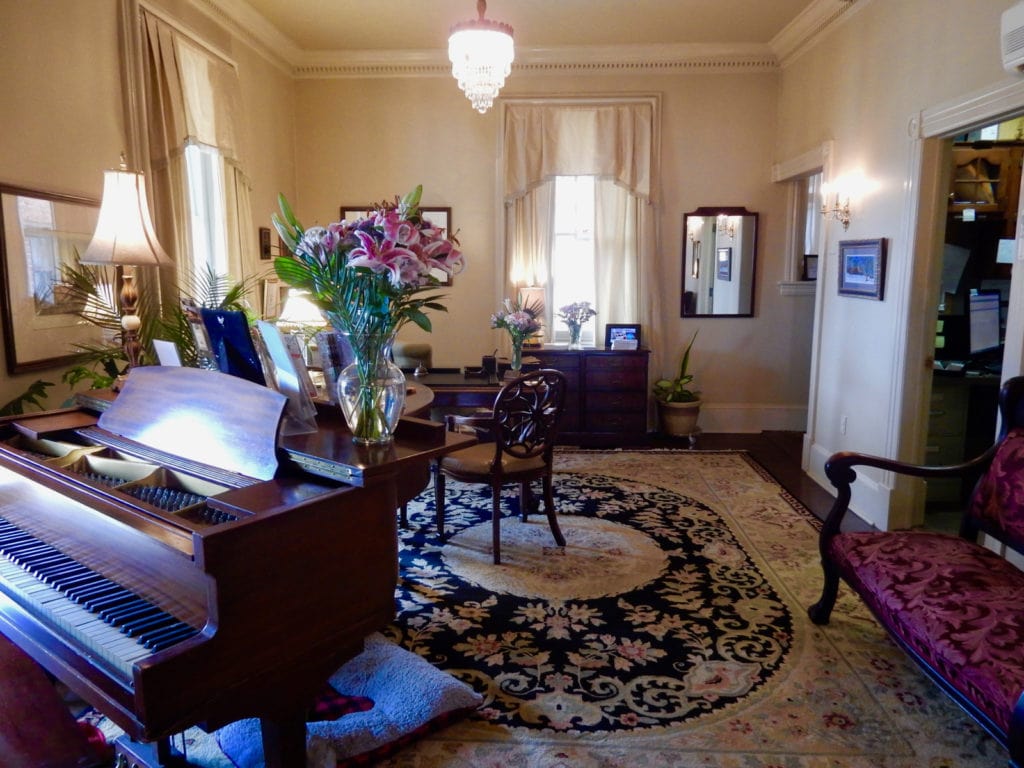
Turned into a boutique inn in the 1990’s, the parlors and dining room remain elegantly majestic. Interior rooms are replete with unusual architectural details such as whitewashed filigreed wrought iron moldings and period paw-foot chairs, brass candlestick sconces, and columned fireplaces.
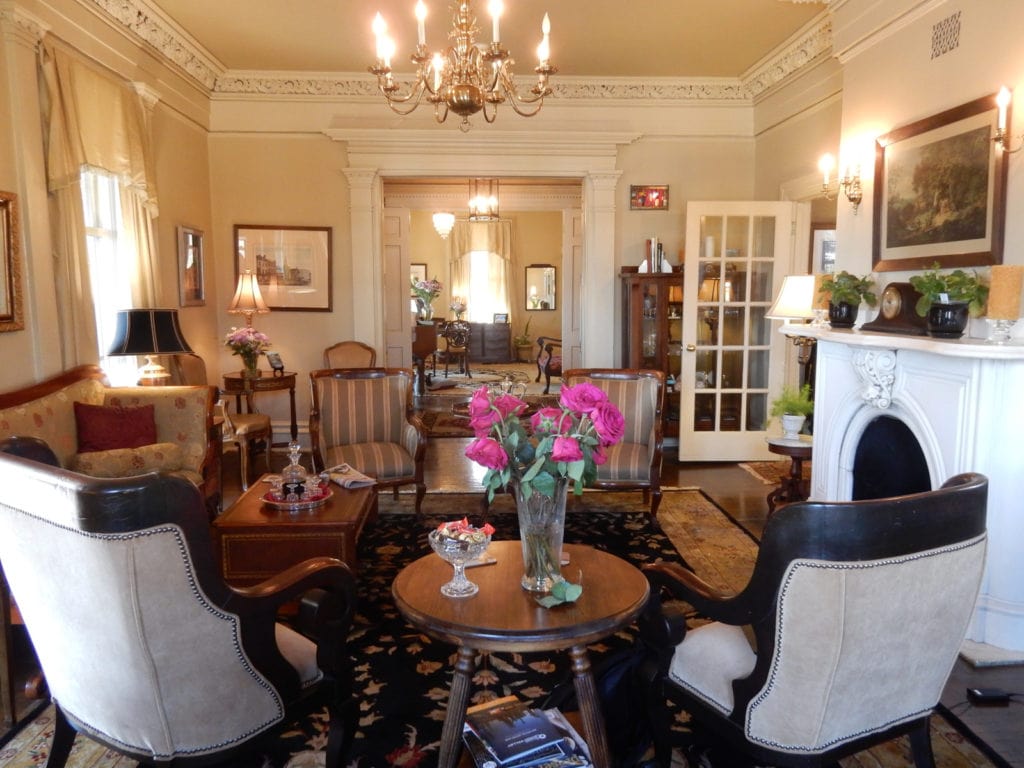
Though elegant, this is a homey place. Repeat visitors – and that includes me – rhapsodize about the Chocolate Chip cookies for the taking in a big glass jar in the parlor. Crispy and full of chocolate chunks, you don’t want to miss them.
Though there are franchise hotels aplenty in the Bethlehem area, businesspeople favor Sayre Mansion for its social, home away from home vibe.
Rooms at Sayre Mansion
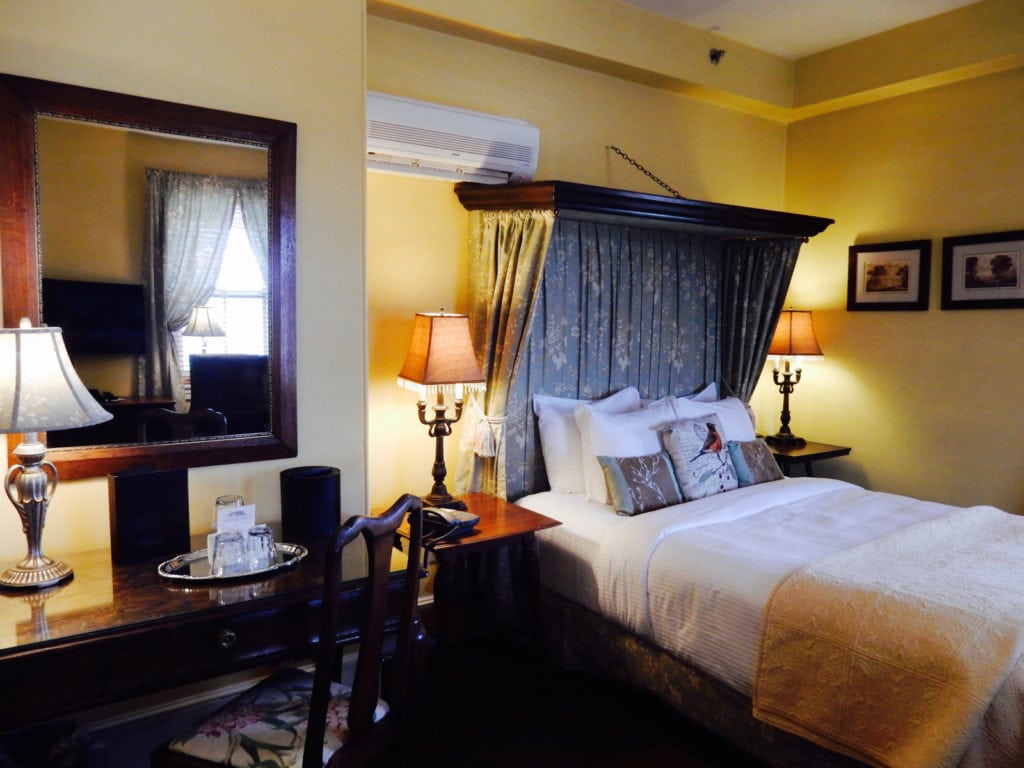
Room décor adheres to original opulent fashions of Sayre’s day. Of course, however, brand new pillow-top, high-thread-count disappear-into-down bedding, flat screen TV’s, and other modern amenities have been added to up the comfort factor in each of the 22 rooms.
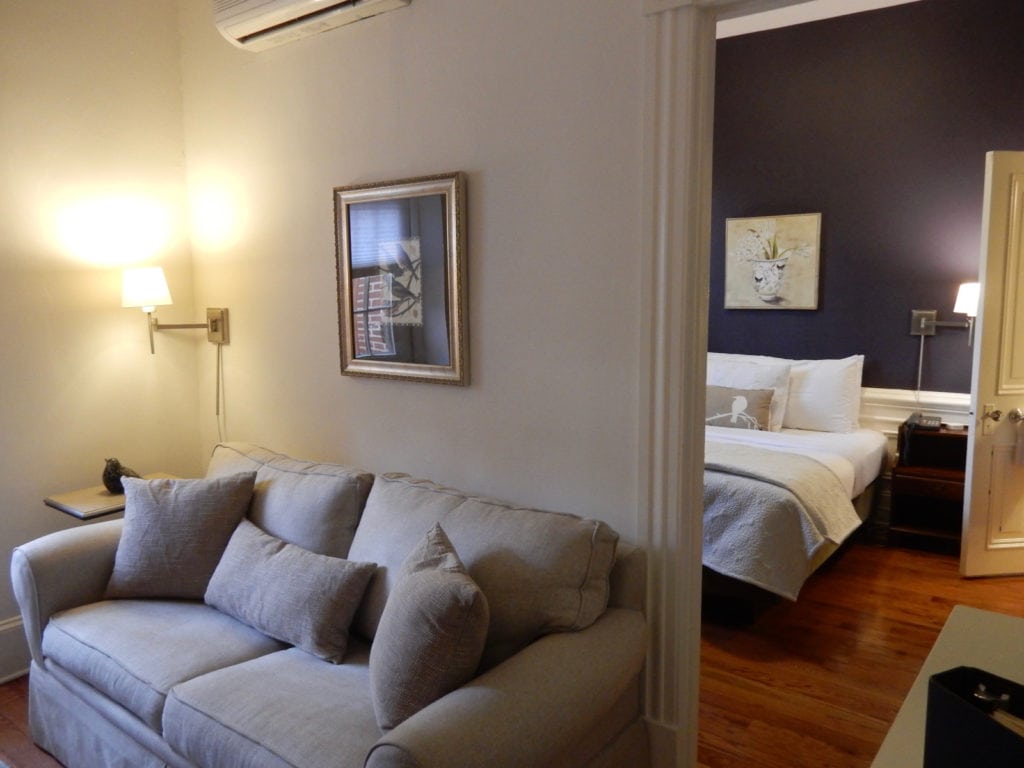
Pristine bathrooms have been recently updated, and though small, sport deep-hued walls.
Food at Sayre Mansion
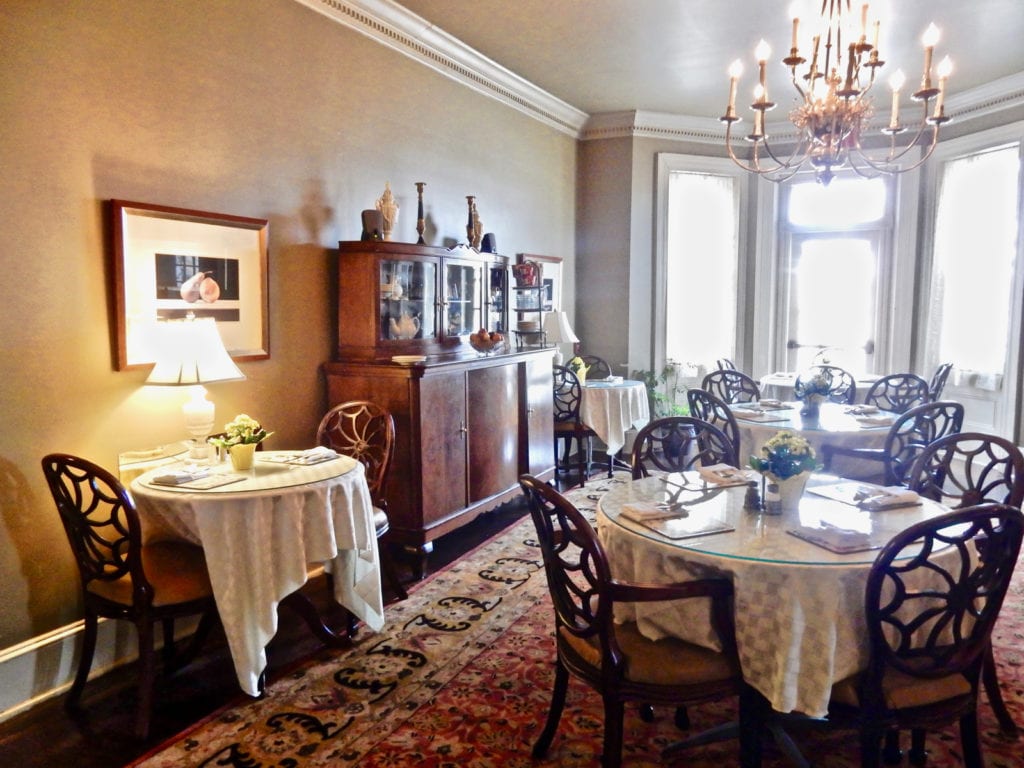
Fresh flowers adorn tables in the former dining room. In the morning, made-to-order breakfast (complementary with room), is a big hit with travelers who appreciate a warm and hearty morning meal in stately surroundings.
And, should you wish to dine in, Sayre Mansion now offers a private dining experience, The Founders Table, for 8 – 18 guests, in the very room that Mr. Sayre would entertain the movers and shakers of Lehigh Valley in the mid 1800’s. These catered dinners must be arranged in advance. In mid 2024, cost was $99 per person. Check website for room rates and availability.
STAY: The Hotel Bethlehem
In the roaring 1920’s, Hotel Bethlehem attracted nattily dressed steel and railroad tycoons. It has surged back to life recently as the most posh full-service hotel in the Lehigh Valley.
Historically significant, the hotel arose on the site of the city’s first structure – a two room log house. Find the plaque on the side of the hotel that reads “In this house on Christmas Eve 1741, Count Zinsendorf, conducting a Love Feast, named this place Bethlehem.”
Try the Moravian Sugar Cake – complimentary with your coffee in the lobby every morning. Traditionally elegant guest rooms are worth taking the slow creaky elevator to get to, and many have wonderful views of Bethlehem’s Historic District.
For more information on what to see and do, check out DiscoverLehighValley.com

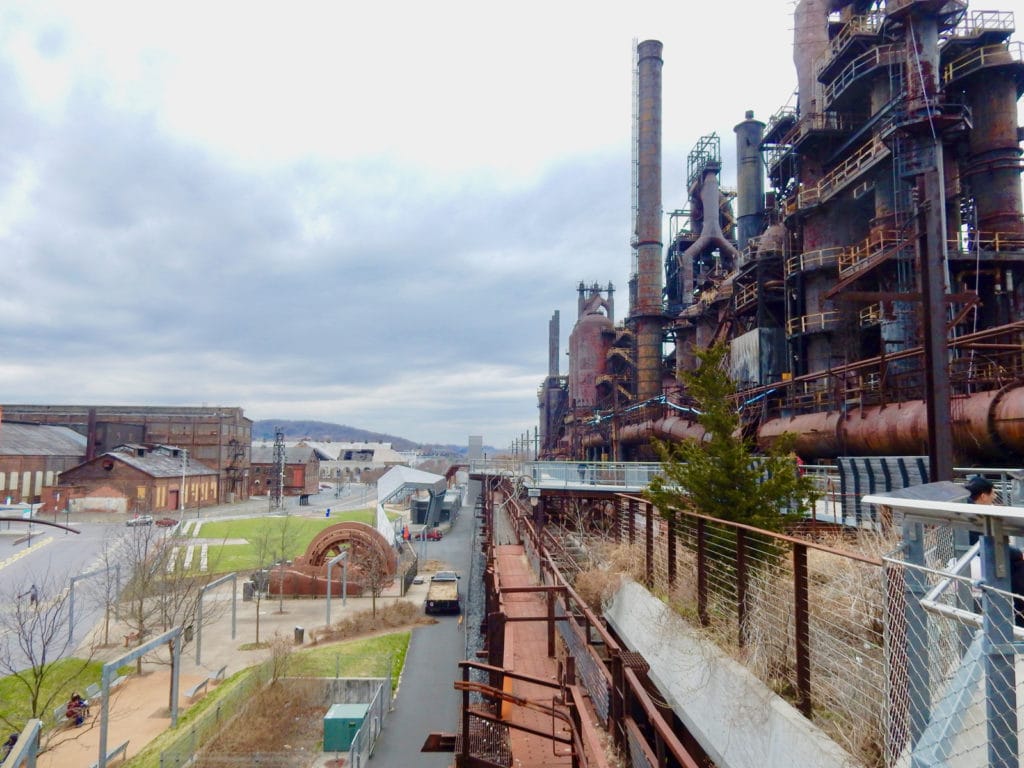
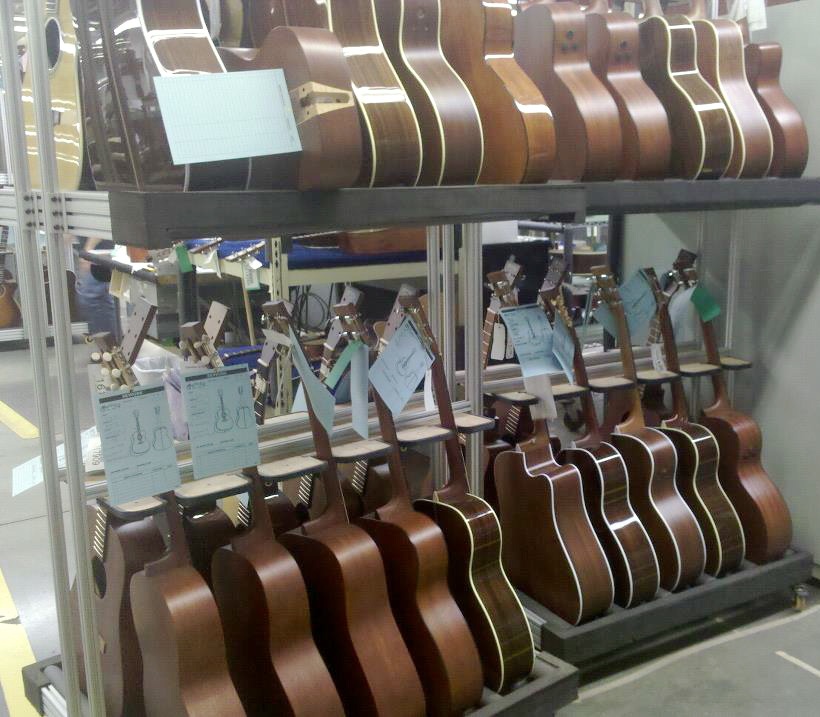
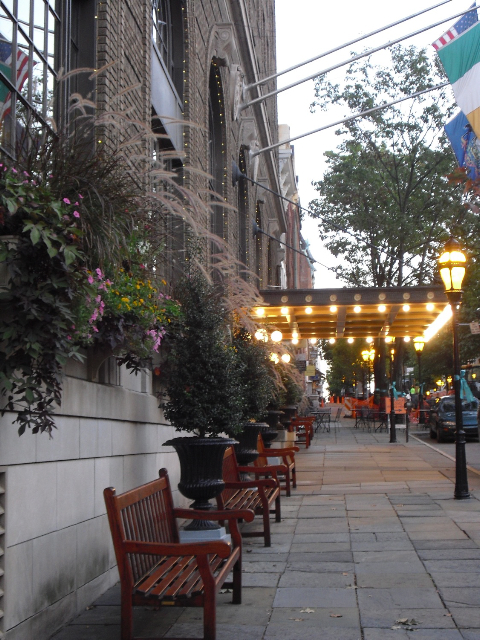
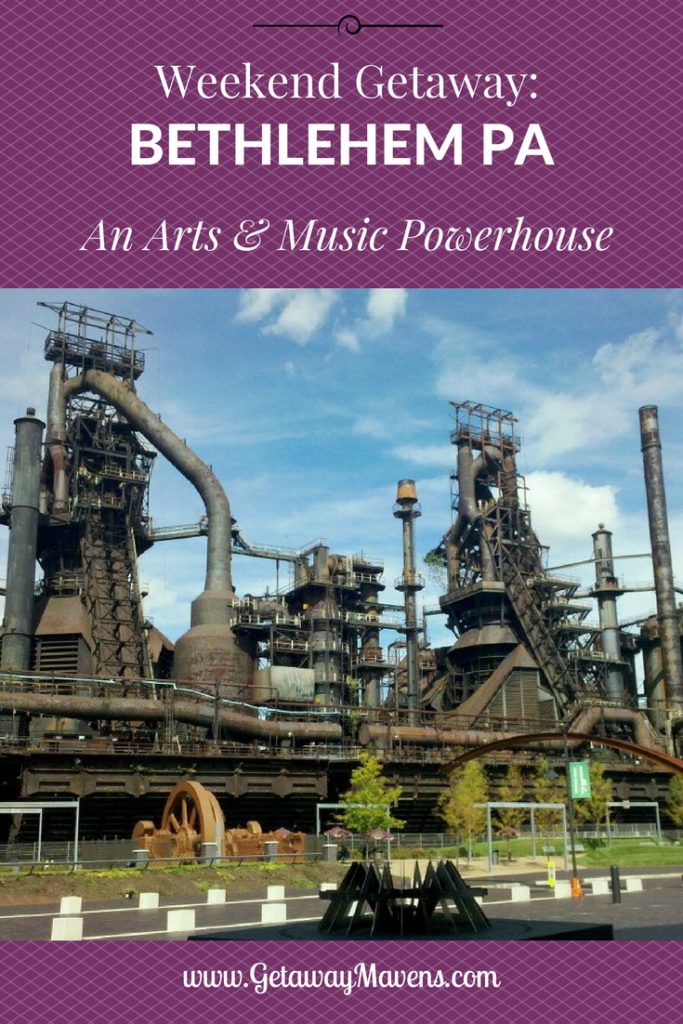

I love the way you’ve formatted this post…lots of eye appeal and easy-to-find info! And which one of you convinced the guy in the quilt to get out his bagpipes and pose for you?!
Billy Joel’s song Allentown is actually about Bethlehem. He used Allentown bcos it worked better lyrically. #truefact
Thanks LGW – I didn’t know that, but it makes complete sense.
Thanks for reading and commenting.
Malerie
This is true. The song is obviously about Bethlehem, but Allentown rhymes with much more.